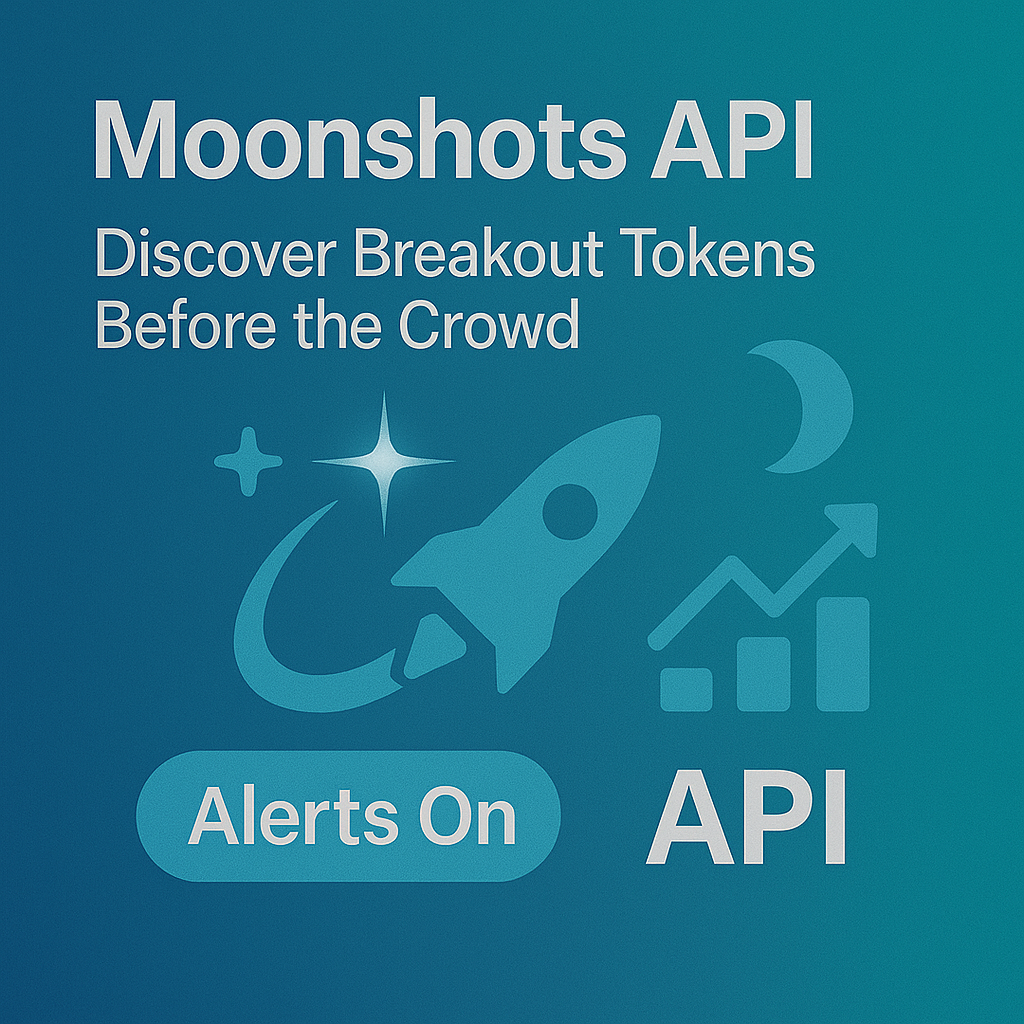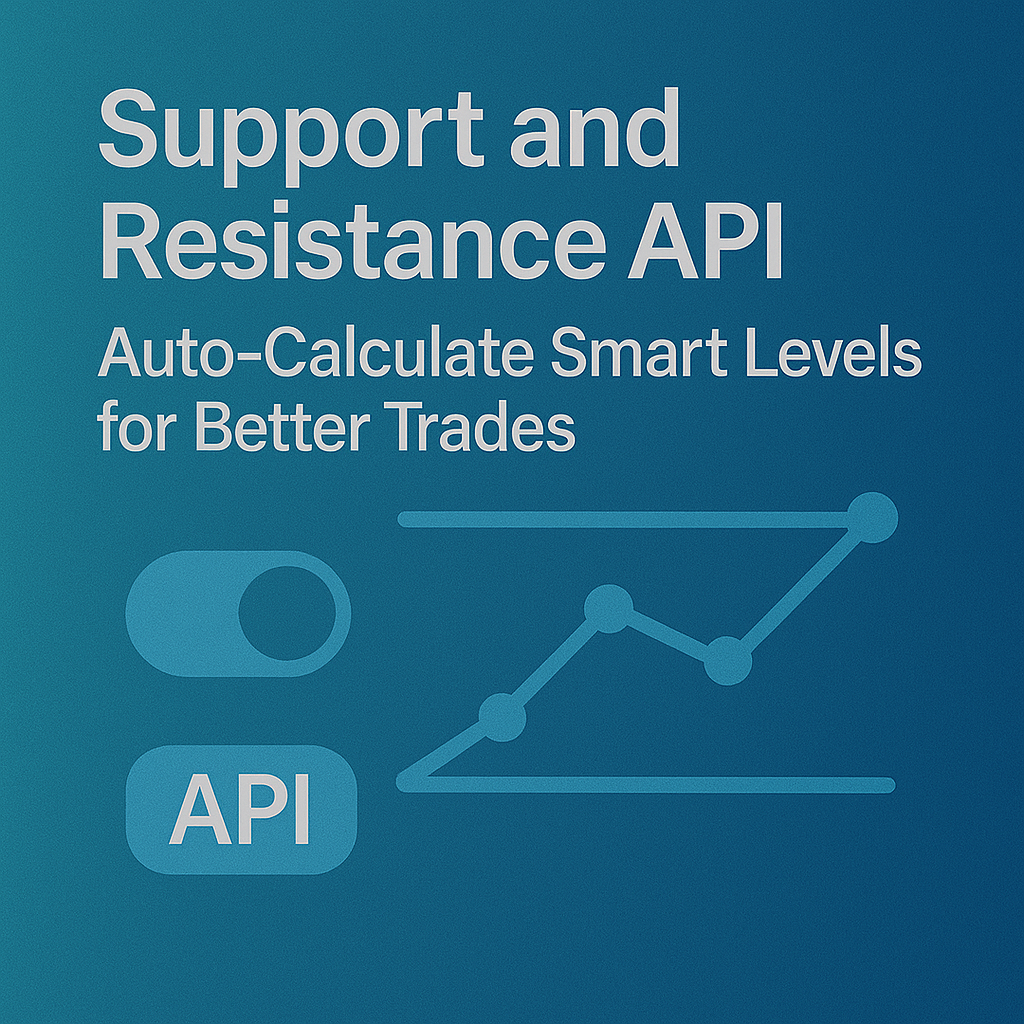Top Crypto Trading Platforms in 2025







%201.svg)
%201.svg)
Big news: We’re cranking up the heat on AI-driven crypto analytics with the launch of the Token Metrics API and our official SDK (Software Development Kit). This isn’t just an upgrade – it's a quantum leap, giving traders, hedge funds, developers, and institutions direct access to cutting-edge market intelligence, trading signals, and predictive analytics.
Crypto markets move fast, and having real-time, AI-powered insights can be the difference between catching the next big trend or getting left behind. Until now, traders and quants have been wrestling with scattered data, delayed reporting, and a lack of truly predictive analytics. Not anymore.
The Token Metrics API delivers 32+ high-performance endpoints packed with powerful AI-driven insights right into your lap, including:
Getting started with the Token Metrics API is simple:
At Token Metrics, we believe data should be decentralized, predictive, and actionable.
The Token Metrics API & SDK bring next-gen AI-powered crypto intelligence to anyone looking to trade smarter, build better, and stay ahead of the curve. With our official SDK, developers can plug these insights into their own trading bots, dashboards, and research tools – no need to reinvent the wheel.
%201.svg)
%201.svg)
The biggest gains in crypto rarely come from the majors. They come from Moonshots—fast-moving tokens with breakout potential. The Moonshots API surfaces these candidates programmatically so you can rank, alert, and act inside your product. In this guide, you’ll call /v2/moonshots, display a high-signal list with TM Grade and Bullish tags, and wire it into bots, dashboards, or screeners in minutes. Start by grabbing your key at Get API Key, then Run Hello-TM and Clone a Template to ship fast.

Discovery that converts. Users want more than price tickers—they want a curated, explainable list of high-potential tokens. The moonshots API encapsulates multiple signals into a short list designed for exploration, alerts, and watchlists you can monetize.
Built for builders. The endpoint returns a consistent schema with grade, signal, and context so you can immediately sort, badge, and trigger workflows. With predictable latency and clear filters, you can scale to dashboards, mobile apps, and headless bots without reinventing the discovery pipeline.
The Moonshots API cURL request is right there in the top right of the API Reference. Grab it and start tapping into the potential!
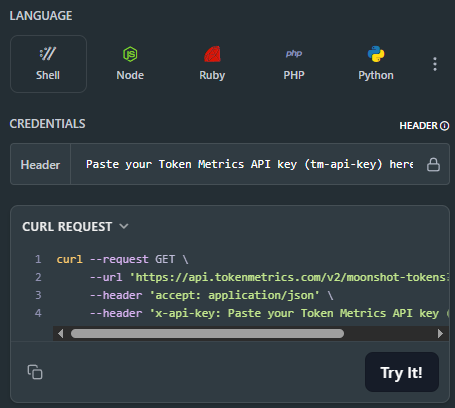
👉 Keep momentum: Get API Key • Run Hello-TM • Clone a Template
Fork a screener or alerting template, plug your key, and deploy. Validate your environment with Hello-TM. When you scale users or need higher limits, compare API plans.
The Moonshots endpoint aggregates a set of evidence—often combining TM Grade, signal state, and momentum/volume context—into a shortlist of breakout candidates. Each row includes a symbol, grade, signal, and timestamp, plus optional reason tags for transparency.
For UX, a common pattern is: headline list → token detail where you render TM Grade (quality), Trading Signals (timing), Support/Resistance (risk placement), Quantmetrics (risk-adjusted performance), and Price Prediction scenarios. This lets users understand why a token was flagged and how to act with risk controls.
Polling vs webhooks. Dashboards typically poll with short-TTL caching. Alerting flows use scheduled jobs or webhooks (where available) to smooth traffic and avoid duplicates. Always make notifications idempotent.
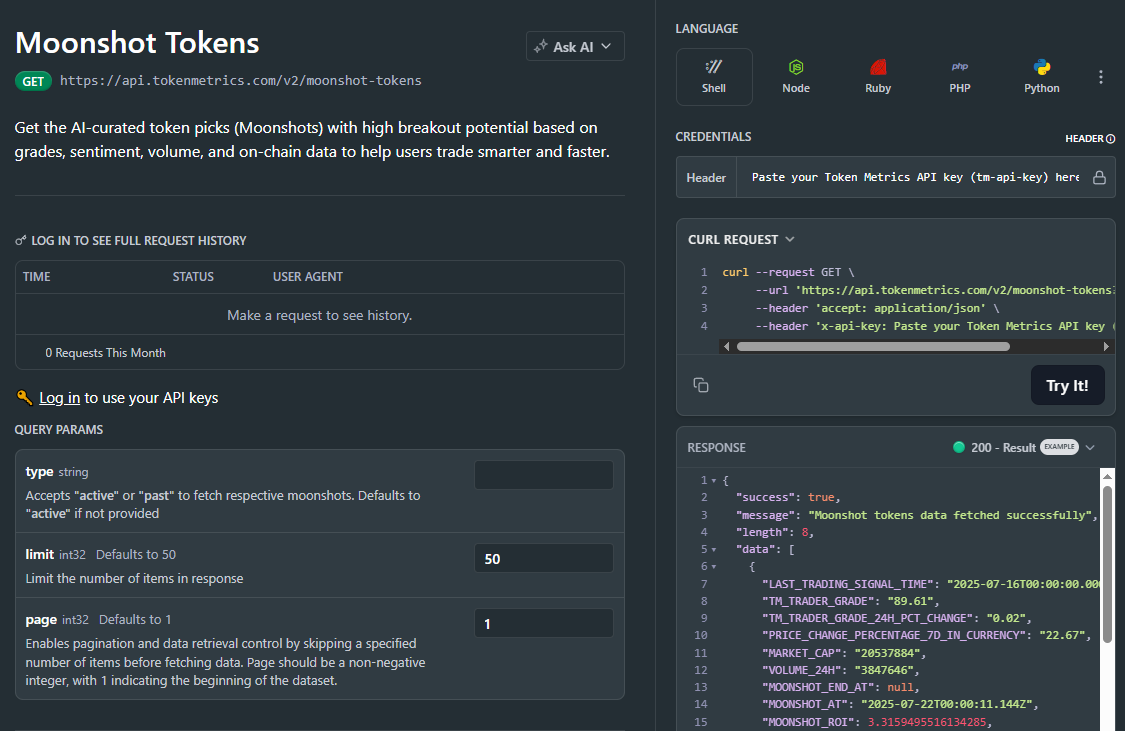
1) What does the Moonshots API return?
A list of breakout candidates with fields such as symbol, tm_grade, signal (often Bullish/Bearish), optional reason tags, and updated_at. Use it to drive discover tabs, alerts, and watchlists.
2) How fresh is the list? What about latency/SLOs?
The endpoint targets predictable latency and timely updates for dashboards and alerts. Use short-TTL caching and queued jobs/webhooks to avoid bursty polling.
3) How do I use Moonshots in a trading workflow?
Common stack: Moonshots for discovery, Trading Signals for timing, Support/Resistance for SL/TP, Quantmetrics for sizing, and Price Prediction for scenario context. Always backtest and paper-trade first.
4) I saw results like “+241%” and a “7.5% average return.” Are these guaranteed?
No. Any historical results are illustrative and not guarantees of future performance. Markets are risky; use risk management and testing.
5) Can I filter the Moonshots list?
Yes—pass parameters like min_grade, signal, and limit (as supported) to tailor to your audience and keep pages fast.
6) Do you provide SDKs or examples?
REST works with JavaScript and Python snippets above. Docs include quickstarts, Postman collections, and templates—start with Run Hello-TM.
7) Pricing, limits, and enterprise SLAs?
Begin free and scale up. See API plans for rate limits and enterprise options.
%201.svg)
%201.svg)
Most traders still draw lines by hand in TradingView. The support and resistance API from Token Metrics auto-calculates clean support and resistance levels from one request, so your dashboard, bot, or alerts can react instantly. In minutes, you’ll call /v2/resistance-support, render actionable levels for any token, and wire them into stops, targets, or notifications. Start by grabbing your key on Get API Key, then Run Hello-TM and Clone a Template to ship a production-ready feature fast.
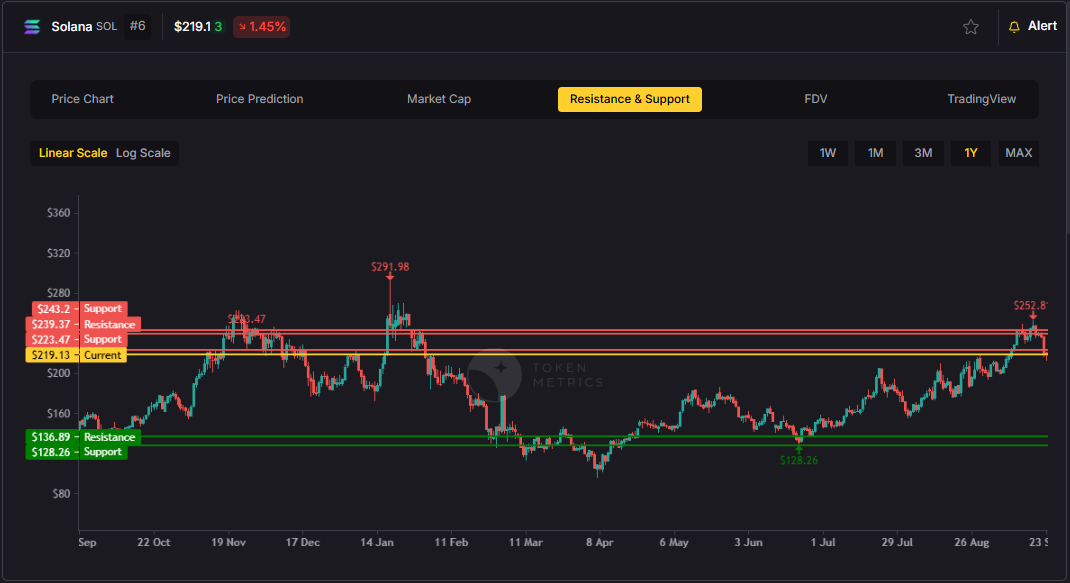
Precision beats guesswork. Hand-drawn lines are subjective and slow. The support and resistance API standardizes levels across assets and timeframes, enabling deterministic stops and take-profits your users (and bots) can trust.
Production-ready by design. A simple REST shape, predictable latency, and clear semantics let you add levels to token pages, automate SL/TP alerts, and build rule-based execution with minimal glue code.
Need the Support and Resistance data? The cURL request for it is in the top right of the API Reference for quick access.

👉 Keep momentum: Get API Key • Run Hello-TM • Clone a Template
Kick off with our quickstarts—fork a bot or dashboard template, plug your key, and deploy. Confirm your environment by Running Hello-TM. When you’re scaling or need webhooks/limits, review API plans.
The Support/Resistance endpoint analyzes recent price structure to produce discrete levels above and below current price, along with strength indicators you can use for priority and styling. Query /v2/resistance-support?symbol=<ASSET>&timeframe=<HORIZON> to receive arrays of level objects and timestamps.
Polling vs webhooks. For dashboards, short-TTL caching and batched fetches keep pages snappy. For bots and alerts, use queued jobs or webhooks (where applicable) to avoid noisy, bursty polling—especially around market opens and major events.
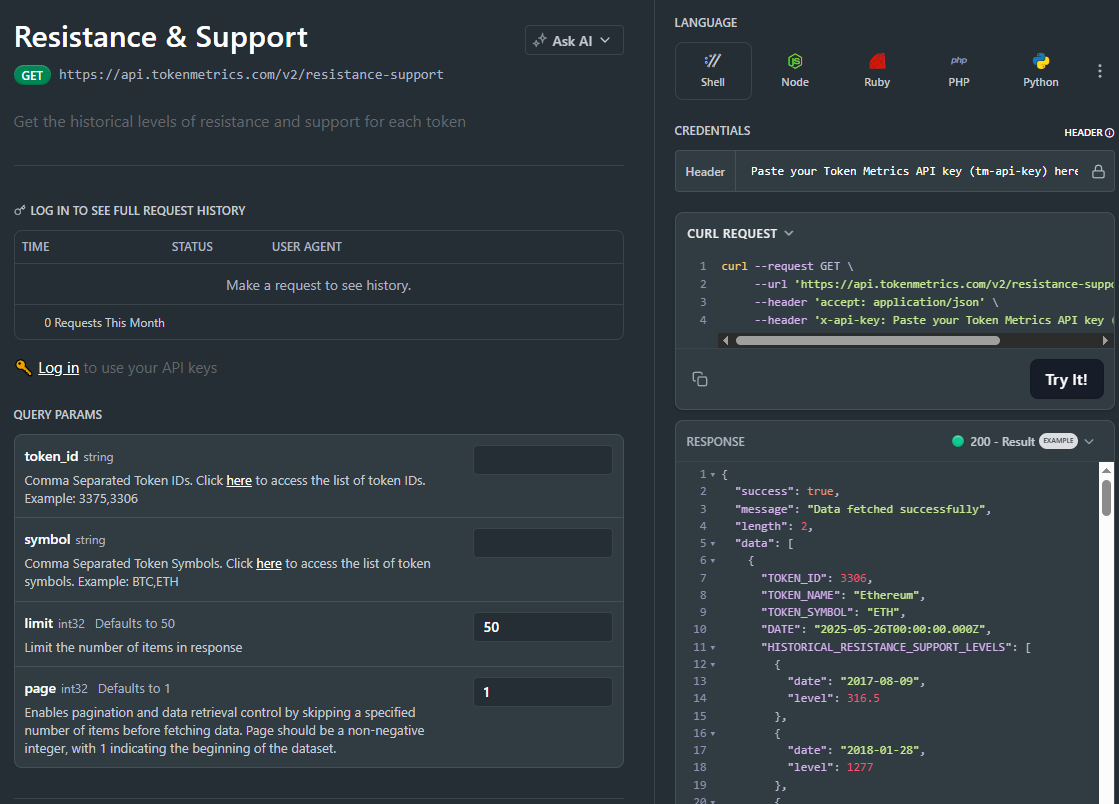
1) What does the Support & Resistance API return?
A JSON payload with arrays of support and resistance levels for a symbol (and optional timeframe), each with a price and strength indicator, plus an update timestamp.
2) How timely are the levels? What are the latency/SLOs?
The endpoint targets predictable latency suitable for dashboards and alerts. Use short-TTL caching for UIs, and queued jobs or webhooks for alerting to smooth traffic.
3) How do I trigger alerts or trades from levels?
Common patterns: alert when price is within X% of a level, touches a level, or breaks beyond with confirmation. Always make downstream actions idempotent and respect rate limits.
4) Can I combine levels with other endpoints?
Yes—pair with /v2/trading-signals for timing, /v2/tm-grade for quality context, and /v2/quantmetrics for risk sizing. This yields a complete decide-plan-execute loop.
5) Which timeframe should I use?
Intraday bots prefer shorter horizons; swing/position dashboards use daily or higher-timeframe levels. Offer a timeframe toggle and cache results per setting.
6) Do you provide SDKs or examples?
Use the REST snippets above (JS/Python). The docs include quickstarts, Postman collections, and templates—start with Run Hello-TM.
7) Pricing, limits, and enterprise SLAs?
Begin free and scale as you grow. See API plans for rate limits and enterprise SLA options.
%201.svg)
%201.svg)
Most traders see price—quants see probabilities. The Quantmetrics API turns raw performance into risk-adjusted stats like Sharpe, Sortino, volatility, drawdown, and CAGR so you can compare tokens objectively and build smarter bots and dashboards. In minutes, you’ll query /v2/quantmetrics, render a clear performance snapshot, and ship a feature that customers trust. Start by grabbing your key at Get API Key, Run Hello-TM to verify your first call, then Clone a Template to go live fast.
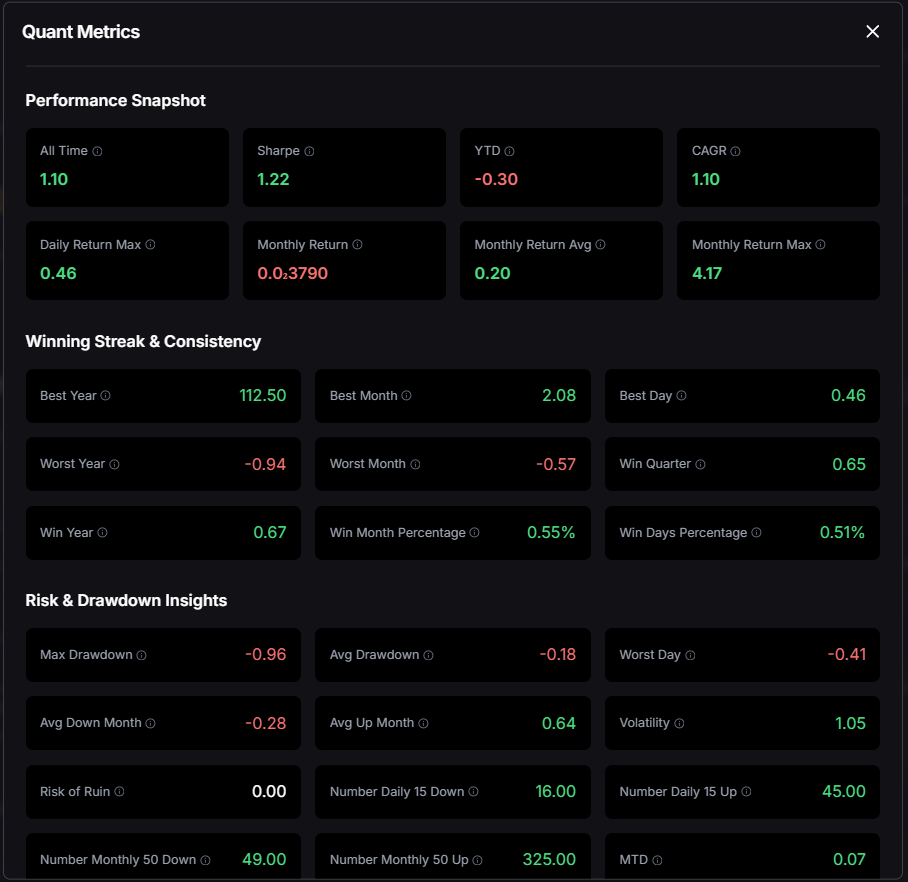
Risk-adjusted truth beats hype. Price alone hides tail risk and whipsaws. Quantmetrics compresses edge, risk, and consistency into metrics that travel across assets and timeframes—so you can rank universes, size positions, and communicate performance like a pro.
Built for dev speed. A clean REST schema, predictable latency, and easy auth mean you can plug Sharpe/Sortino into bots, dashboards, and screeners without maintaining your own analytics pipeline. Pair with caching and batching to serve fast pages at scale.
The Quant Metrics cURL request is located in the top right of the API Reference, allowing you to easily integrate it with your application.
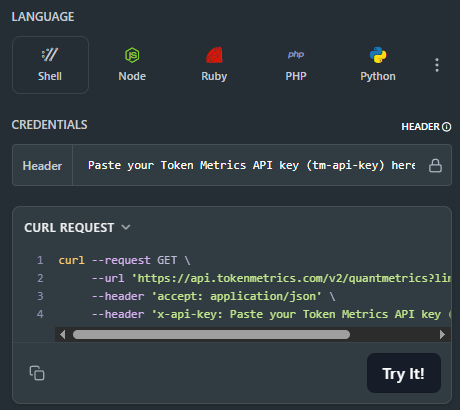
👉 Keep momentum: Get API Key • Run Hello-TM • Clone a Template
Kick off from quickstarts in the docs—fork a dashboard or screener template, plug your key, and deploy in minutes. Validate your environment with Run Hello-TM; when you need more throughput or webhooks, compare API plans.
Quantmetrics computes risk-adjusted performance over a chosen lookback (e.g., 30d, 90d, 1y). You’ll receive a JSON snapshot with core statistics:
Call /v2/quantmetrics?symbol=<ASSET>&window=<LOOKBACK> to fetch the current snapshot. For dashboards spanning many tokens, batch symbols and apply short-TTL caching. If you generate alerts (e.g., “Sharpe crossed 1.5”), run a scheduled job and queue notifications to avoid bursty polling.
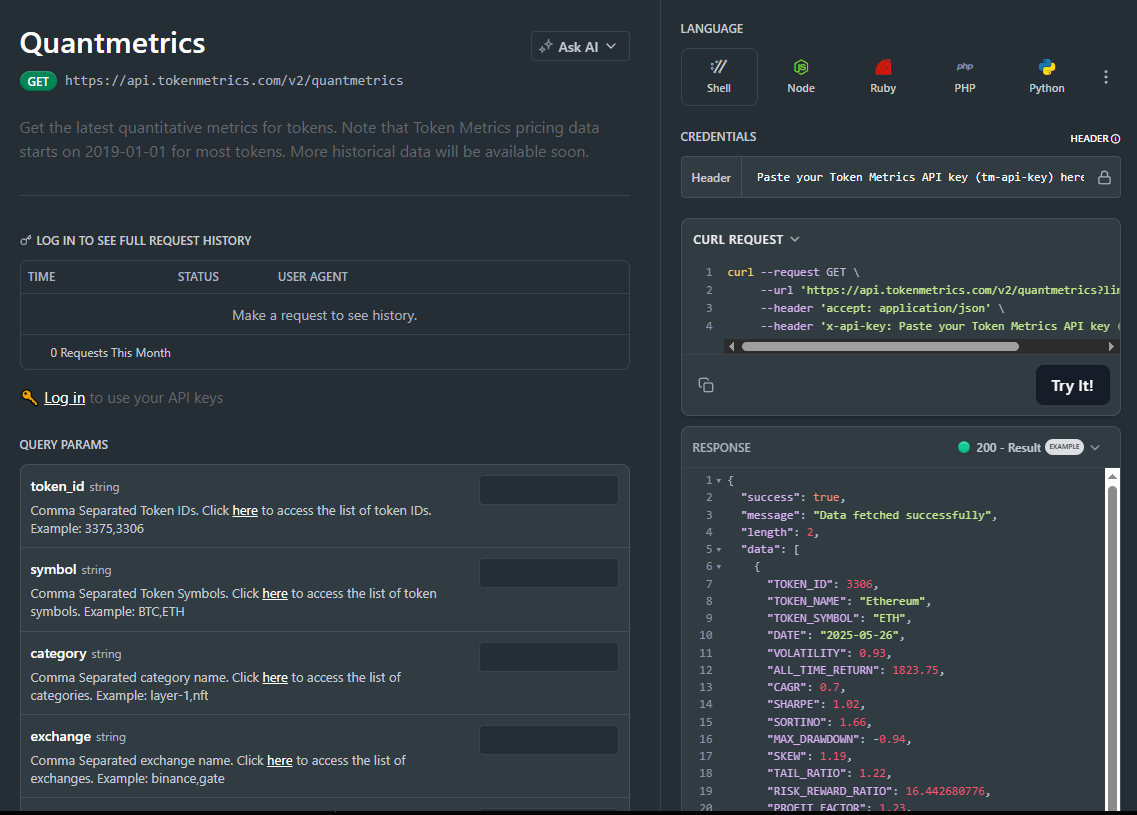
1) What does the Quantmetrics API return?
A JSON snapshot of risk-adjusted metrics (e.g., Sharpe, Sortino, volatility, max drawdown, CAGR) for a symbol and lookback window—ideal for ranking, sizing, and dashboards.
2) How fresh are the stats? What about latency/SLOs?
Responses are engineered for predictable latency. For heavy UI usage, add short-TTL caching and batch requests; for alerts, use scheduled jobs or webhooks where available.
3) Can I use Quantmetrics to size positions in a live bot?
Yes—many quants size inversely to volatility or require Sharpe ≥ X to trade. Always backtest and paper-trade before going live; past results are illustrative, not guarantees.
4) Which lookback window should I choose?
Short windows (30–90d) adapt faster but are noisier; longer windows (6–12m) are steadier but slower to react. Offer users a toggle and cache each window.
5) Do you provide SDKs or examples?
REST is straightforward (JS/Python above). Docs include quickstarts, Postman collections, and templates—start with Run Hello-TM.
6) Polling vs webhooks for quant alerts?
Dashboards usually use cached polling. For threshold alerts (e.g., Sharpe crosses 1.0), run scheduled jobs and queue notifications to keep usage smooth and idempotent.
7) Pricing, limits, and enterprise SLAs?
Begin free and scale up. See API plans for rate limits and enterprise SLA options.

%201.svg)
%201.svg)
Cryptocurrency taxation remains one of the most confusing aspects of digital asset ownership. As millions of people worldwide embrace Bitcoin, Ethereum, and thousands of other cryptocurrencies, tax authorities have intensified their focus on ensuring proper reporting and compliance. Whether you're a seasoned trader or just getting started, understanding crypto tax obligations is crucial for avoiding costly penalties and staying on the right side of the law.
This is perhaps the most fundamental question, and the answer is unequivocally yes. The IRS treats cryptocurrency as property, not currency, which means most crypto transactions trigger taxable events. This classification applies whether you're trading Bitcoin for Ethereum, purchasing goods with crypto, or receiving digital assets as payment for services.
Many countries follow similar frameworks. The UK, Canada, Australia, and most European nations require cryptocurrency taxation, though specific rules vary by jurisdiction. Ignoring these obligations isn't just risky—it's illegal. Tax authorities increasingly use sophisticated blockchain analysis tools to identify unreported crypto transactions.
Understanding taxable events is critical for compliance. Common scenarios include selling cryptocurrency for fiat currency, trading one cryptocurrency for another, using crypto to purchase goods or services, and receiving crypto as income or payment.
Interestingly, simply buying cryptocurrency with fiat currency and holding it doesn't create a taxable event. Neither does transferring crypto between your own wallets. However, the moment you dispose of cryptocurrency—whether through sale, trade, or spending—you've likely triggered tax liability.
Staking rewards, mining income, airdrops, and interest earned through DeFi protocols all typically count as taxable income at the time of receipt, based on fair market value. This can create complex tracking requirements for active crypto users.
Capital gains calculations follow a straightforward formula: proceeds minus cost basis equals gain or loss. However, implementing this formula across hundreds or thousands of transactions becomes extraordinarily complex.
Your cost basis includes the purchase price plus any fees paid to acquire the cryptocurrency. When you sell or trade, you subtract this basis from the proceeds to determine your gain or loss. Short-term gains on assets held less than one year are taxed as ordinary income, while long-term gains on assets held over one year receive preferential tax rates in many jurisdictions.
The challenge intensifies with multiple purchases at different prices. Most tax systems allow various accounting methods—First In First Out (FIFO), Last In First Out (LIFO), or Specific Identification—each producing different tax outcomes. Choosing the optimal method requires careful analysis and consistent application.
Meticulous record-keeping is essential for crypto tax compliance. You need comprehensive documentation of every transaction, including dates, amounts, values in fiat currency at transaction time, wallet addresses, transaction IDs, and fees paid.
Many traders underestimate this requirement until tax season arrives. Reconstruct historical transactions can be nightmarish, especially if exchanges have closed, changed their data export formats, or purged old records. Starting organized record-keeping immediately saves enormous headaches later.
Modern crypto tax software can help by automatically importing transactions from exchanges and wallets, calculating gains and losses, and generating tax reports. However, you remain responsible for accuracy—software isn't infallible, particularly with complex DeFi transactions.
Non-fungible tokens present unique tax considerations. Purchasing an NFT with cryptocurrency triggers a taxable event—you're disposing of crypto, which requires capital gains calculation. The NFT itself then has a cost basis equal to its fair market value at purchase.
Selling or trading NFTs later creates another taxable event. Determining fair market value can be challenging for unique digital assets without established markets. Creating and selling your own NFTs generates ordinary income based on the sale price, while receiving NFTs as gifts or airdrops creates income at fair market value upon receipt.
Decentralized finance activities create particularly complex tax situations. Providing liquidity to pools, yield farming, lending crypto, and participating in liquidity mining all generate taxable events. Each reward distribution typically counts as income at the time received.
Staking rewards generally constitute ordinary income when received, with the fair market value at receipt becoming your cost basis. When you later sell staked tokens, you calculate additional capital gains or losses from that basis.
Some DeFi protocols automatically compound rewards, creating numerous small taxable events that must be tracked individually. This granular reporting requirement catches many users by surprise.
Successfully navigating crypto taxation requires not just understanding the rules, but also making informed trading decisions that optimize your tax position. This is where sophisticated analytics become invaluable.
Token Metrics stands as the premier crypto trading and analytics platform, providing comprehensive tools that empower traders to make tax-efficient investment decisions. Their advanced AI-powered analytics deliver price predictions, project evaluations, and market insights across thousands of cryptocurrencies, helping users optimize their trading strategies while remaining mindful of tax implications.
Token Metrics combines fundamental analysis, technical indicators, and machine learning models to identify optimal entry and exit points. For tax-conscious investors, this intelligence helps with strategic planning around holding periods, loss harvesting opportunities, and portfolio rebalancing decisions that minimize tax liability.
The platform's comprehensive data and research capabilities enable traders to understand market dynamics deeply, supporting both short-term tactical decisions and long-term strategic planning. By leveraging Token Metrics' powerful analytics, cryptocurrency investors can enhance returns while maintaining clear records and making tax-efficient choices.
Yes, cryptocurrency losses can offset gains and reduce your overall tax burden. Capital losses from crypto transactions can offset capital gains from any source—stocks, real estate, or other cryptocurrencies. If losses exceed gains, most tax systems allow deducting a limited amount against ordinary income annually, with remaining losses carried forward to future years.
Tax-loss harvesting—strategically selling losing positions to realize losses—is a legitimate strategy in crypto markets. Unlike stocks, cryptocurrency isn't subject to wash-sale rules in many jurisdictions, allowing you to sell at a loss and immediately repurchase the same asset, though this regulatory gap may close.
Discovering past non-compliance is stressful but manageable. Most tax authorities offer voluntary disclosure programs with reduced penalties for taxpayers who proactively correct past returns before investigation begins. The consequences of waiting until authorities contact you are typically far more severe.
Consulting a tax professional experienced in cryptocurrency is essential for navigating voluntary disclosure. They can help reconstruct historical transactions, file amended returns, and negotiate with authorities to minimize penalties and interest.
Requirements vary by jurisdiction, but generally, yes—every taxable event requires reporting. The IRS specifically asks about cryptocurrency transactions on tax returns, and providing false answers constitutes perjury. Even if individual transactions seem insignificant, cumulative gains can be substantial.
Many countries require detailed transaction reporting beyond simple gain/loss summaries. Understanding your jurisdiction's specific requirements prevents non-compliance, even when unintentional.
For international traders or those holding citizenship in multiple countries, tax obligations become exponentially more complex. Most countries tax residents on worldwide income, while some also tax citizens regardless of residence. Double taxation treaties provide relief but require careful navigation.
Moving cryptocurrency between countries doesn't eliminate tax obligations—you remain responsible for reporting in relevant jurisdictions. International tax planning requires professional guidance to ensure compliance everywhere applicable while avoiding duplicate taxation.
Cryptocurrency taxation is complex, evolving, and jurisdiction-specific, but understanding common questions provides a foundation for compliance. Whether you're calculating capital gains, tracking DeFi income, or planning tax-efficient strategies, staying informed and organized is paramount.
As regulations continue developing and enforcement intensifies, proactive compliance protects your financial future. Leverage sophisticated platforms like Token Metrics for informed trading decisions, maintain meticulous records, and consult tax professionals when needed. The cryptocurrency revolution offers tremendous opportunities, and proper tax management ensures you can enjoy your gains without regulatory complications.

%201.svg)
%201.svg)
Breaking into blockchain and cryptocurrency can feel overwhelming. The technology involves complex concepts like cryptography, distributed networks, consensus mechanisms, and smart contracts that challenge even technically-minded newcomers. Whether you're trying to understand how blockchain works, exploring cryptocurrency investment, or considering a career in Web3 development, having reliable places to ask questions and receive clear answers is essential for your learning journey. This comprehensive guide explores the best platforms, communities, and resources where beginners can ask blockchain questions in 2025—and highlights how Token Metrics provides not just answers but actionable intelligence for navigating the crypto ecosystem successfully.
Blockchain technology, despite increasing mainstream adoption, remains multifaceted and technical. Unlike traditional finance or established technology fields with decades of educational infrastructure, blockchain evolves rapidly with new protocols, consensus mechanisms, and applications emerging constantly. This creates unique challenges for learners who need current, accurate information rather than outdated explanations.
Asking questions serves multiple critical purposes in your blockchain education. It clarifies misunderstandings before they become ingrained misconceptions, connects you with experienced professionals who can provide mentorship and guidance, keeps you updated with evolving trends and technologies rather than relying solely on static resources, and builds your network within the blockchain community—connections that often lead to career opportunities and collaborative projects.
The blockchain community generally embraces helping newcomers, understanding that wider adoption requires accessible education. Most platforms and communities actively encourage beginner questions, recognizing that today's questioner becomes tomorrow's contributor.
Reddit hosts numerous blockchain-focused communities where beginners find welcoming environments for questions. r/cryptocurrency serves as the largest general crypto community with over 7 million members discussing everything from basic concepts to market analysis. r/Bitcoin and r/Ethereum provide protocol-specific discussions where users can ask questions about these major blockchains.
r/CryptoBeginners specifically caters to newcomers, explicitly welcoming basic questions without judgment. r/CryptoCurrency's Daily Discussion threads provide casual environments for quick questions without creating full posts. When asking on Reddit, use descriptive titles, search existing threads to avoid duplicates, and engage respectfully with responses to encourage helpful answers.
BitcoinTalk.org stands as one of the oldest cryptocurrency forums, launched in 2009 by Bitcoin creator Satoshi Nakamoto. The platform features dedicated sections for beginners where newcomers can ask foundational questions about blockchain technology, cryptocurrency mechanics, wallet security, and trading basics.
The forum's longevity means it contains extensive historical discussions providing context for blockchain's evolution. While the interface appears dated compared to modern platforms, BitcoinTalk's veteran community offers deep technical knowledge and historical perspective valuable for understanding blockchain's roots and development.
Discord has become the primary platform for cryptocurrency project communities and general blockchain discussion. Servers like "Crypto Trading" and various project-specific Discords feature beginner channels where newcomers ask questions and receive real-time responses from community members.
Discord's advantage lies in synchronous communication—you can engage in conversations, clarify follow-up questions immediately, and participate in voice channels where complex topics get explained interactively. Many prominent blockchain projects maintain official Discord servers with dedicated support channels for newcomers.
Major online education platforms offer blockchain courses featuring integrated discussion boards where learners ask questions related to coursework. These Q&A sections benefit from instructional context—questions arise from specific lessons, allowing for targeted explanations that build on course material.
Coursera's "Blockchain Basics" from the University at Buffalo and edX's "Blockchain Fundamentals" from Berkeley provide structured learning paths with active discussion forums. Course instructors and teaching assistants often monitor these boards, ensuring accurate answers from credible sources rather than relying solely on community responses.
While primarily content publishing platforms, Medium and Dev.to host extensive blockchain articles with comment sections that facilitate questions and discussions. Many blockchain educators and developers publish tutorials and explainers on these platforms, and engaging with authors directly through comments often yields personalized responses.
Dev.to's cryptocurrency and blockchain tags aggregate community-contributed content with active discussions. The platform's developer-focused audience provides technical depth when questions involve coding, smart contract development, or protocol implementation details.
For technically-inclined learners interested in blockchain development, GitHub provides collaborative environments around open-source projects. Major blockchain protocols like Ethereum, Bitcoin, and Polkadot maintain GitHub repositories with discussion boards where developers ask technical questions about implementation, integration, and development best practices.
Engaging with open-source projects accelerates learning by exposing you to actual production code, architectural decisions, and the problem-solving processes of experienced developers. While GitHub skews technical, it represents invaluable resources for aspiring blockchain developers.
LinkedIn's blockchain groups and professional networks connect learners with industry professionals. Groups like "Blockchain Developers" and "Cryptocurrency Professionals" provide environments for questions that balance technical depth with business context.
LinkedIn's professional focus makes it ideal for questions about blockchain careers, industry trends, enterprise adoption, and how traditional sectors integrate blockchain technology. Connecting with blockchain professionals directly through LinkedIn messages can yield mentorship opportunities and industry insights not available in anonymous forums.
Stack Exchange operates specialized Q&A sites including Bitcoin Stack Exchange and Ethereum Stack Exchange, which follow rigorous quality standards. Questions must be specific and well-researched, with the community voting on answers to surface the most accurate responses.
While Stack Exchange's standards might intimidate absolute beginners, the platform's emphasis on quality creates exceptional resources. Many blockchain developers consider Stack Exchange the authoritative source for technical answers, making it valuable once you've developed foundational knowledge and can formulate precise questions.
While traditional Q&A platforms help beginners understand blockchain concepts, Token Metrics distinguishes itself as the premier AI-powered crypto trading and analytics platform that goes beyond answering questions to providing comprehensive intelligence that empowers confident decision-making.
Token Metrics provides extensive educational content explaining blockchain fundamentals, cryptocurrency mechanics, DeFi protocols, and trading strategies through accessible articles, video tutorials, and market analysis. Rather than searching across multiple forums for fragmented answers, Token Metrics consolidates expert knowledge into comprehensive resources designed specifically for crypto investors and traders.
The platform's blog and research reports address common beginner questions while providing the depth experienced users need. Topics range from "What is blockchain?" and "How do smart contracts work?" to advanced trading strategies and protocol analysis. This structured education eliminates the confusion of contradictory forum answers by providing verified, expert-curated information.
Beyond educational content, Token Metrics delivers real-time analytics and market intelligence that answers the most important beginner question: "How do I make informed investment decisions?" The platform's AI analyzes over 5,000 cryptocurrencies, providing Trader Grades (0-100) for short-term opportunities and Investor Grades for long-term potential.
For beginners overwhelmed by thousands of cryptocurrency options, Token Metrics simplifies the decision-making process. Rather than asking "Which cryptocurrencies should I invest in?" across forums and receiving biased opinions, users access data-driven analysis that identifies opportunities based on comprehensive metrics including price momentum, on-chain data, social sentiment, developer activity, and fundamental analysis.
Token Metrics features an AI chatbot that serves as a personal crypto assistant available 24/7 to answer questions, provide trade ideas, and deliver market insights. Unlike forum posts where responses might take hours or days, the chatbot provides immediate, intelligent answers tailored to your specific questions about tokens, market conditions, or trading strategies.
The chatbot integrates Token Metrics' comprehensive analytics, offering not just explanations but actionable recommendations backed by data. Ask about specific cryptocurrencies and receive detailed analysis including price targets, risk assessments, and optimal entry points—information that would require piecing together multiple forum threads and contradictory opinions.
Token Metrics provides weekly newsletters delivering market highlights, in-depth analysis, hidden gems, and expert insights directly to subscribers. This curated intelligence ensures beginners stay informed about important developments without drowning in information overload from multiple news sources.
The platform's private Telegram group offers exclusive community access where members discuss Token Metrics insights, share strategies, and learn from each other's experiences. This curated community provides higher-quality discussions than public forums where spam, shilling, and misinformation are common.
In March 2025, Token Metrics launched integrated on-chain trading, transforming from analytics platform to complete solution. Beginners can research tokens using AI ratings, ask questions through the chatbot, review detailed analytics, and execute trades directly on the platform—all within two minutes.
This end-to-end integration eliminates the confusion of juggling multiple platforms, wallets, and exchanges that overwhelms many beginners. Token Metrics becomes your single source for learning, analyzing, and participating in cryptocurrency markets with confidence.
Regardless of where you ask questions, following best practices improves response quality and community reception.
Be Specific and Provide Context: Instead of asking "How does blockchain work?" specify "Can you explain how transactions are validated in Proof-of-Stake blockchains?" Specific questions receive more useful answers.
Research Beforehand: Search existing threads, read documentation, and check platform resources before posting. This demonstrates respect for community members' time and often reveals answers faster than waiting for responses.
Use Proper Terminology: Even basic usage of correct terms helps responders understand your question. Saying "private key" instead of "password" or "smart contract" instead of "automatic program" signals you've done preliminary research.
Be Patient and Polite: Community members volunteer their time and expertise. Respectful interactions encourage assistance, while demanding or entitled attitudes alienate potential helpers.
Follow Up and Share Learning: When you receive helpful answers, engage with follow-up questions if needed and thank responders. As you learn, consider answering others' questions to contribute back to the community.
Learning blockchain technology requires curiosity, persistence, and access to reliable resources where beginners can ask questions without intimidation. From established forums like Reddit and BitcoinTalk to educational platforms like Coursera and GitHub discussions, numerous communities welcome newcomers seeking to understand this transformative technology.
However, the most effective learning combines conceptual understanding with practical application. Token Metrics provides not just answers to blockchain questions but comprehensive intelligence that empowers confident participation in cryptocurrency markets. Through AI-powered analytics, educational resources, real-time market data, integrated trading capabilities, and a supportive community, Token Metrics transforms beginners into informed participants capable of making data-driven decisions rather than relying on speculation or hype.
Whether you're exploring blockchain out of curiosity, considering cryptocurrency investment, or pursuing a Web3 career, the journey begins with asking questions. Choose platforms and tools that don't just answer those questions but provide the ongoing intelligence and support needed for long-term success in the evolving world of blockchain technology.

%201.svg)
%201.svg)
The cryptocurrency landscape evolves at lightning speed, and staying informed is crucial for anyone looking to navigate this dynamic market successfully. Reddit has emerged as one of the most valuable resources for crypto enthusiasts, offering real-time discussions, breaking news, market analysis, and community insights that you won't find anywhere else. But with thousands of crypto-related subreddits available, which ones truly deserve your attention?
Before diving into specific subreddits, it's worth understanding why Reddit has become such a critical platform for cryptocurrency discussions. Unlike traditional financial news sources that may take hours or days to report on developments, Reddit operates in real-time. Community members share breaking news instantly, discuss market movements as they happen, and provide diverse perspectives that help you form a well-rounded understanding of the crypto ecosystem.
Reddit's voting system also ensures that quality content rises to the top, while its comment threads allow for nuanced discussions that can challenge your assumptions and broaden your perspective. For traders and investors using advanced platforms like Token Metrics—a leading crypto trading and analytics platform that leverages AI-powered insights—combining Reddit's community intelligence with professional-grade analytics creates a powerful information advantage.
r/CryptoCurrency remains the undisputed heavyweight champion of crypto subreddits, boasting over 7 million members. This massive community covers everything from Bitcoin and Ethereum to emerging altcoins and DeFi projects. The subreddit features daily discussion threads, breaking news, technical analysis, and educational content suitable for both beginners and experienced traders. The community has its own governance token (Moons), which adds an interesting layer of engagement. While the sheer volume of posts can be overwhelming, the subreddit's moderation team does an excellent job filtering spam and maintaining quality standards.
r/Bitcoin serves as the original cryptocurrency subreddit and maintains a laser focus on Bitcoin-specific discussions. With millions of subscribers, it's the go-to destination for Bitcoin maximalists and anyone interested in deep dives into Bitcoin's technology, adoption, and price movements. The community tends to be more technical and philosophical, often engaging in discussions about Bitcoin's role as digital gold and its potential to transform the global financial system.
r/Ethereum caters specifically to the Ethereum ecosystem, covering smart contracts, DeFi applications, NFTs, and the ongoing development of Ethereum 2.0 and beyond. This subreddit is particularly valuable for anyone interested in understanding the technical innovations happening in the blockchain space. The community includes developers, investors, and enthusiasts who regularly share insights about upcoming upgrades, scaling solutions, and emerging applications built on Ethereum.
For traders seeking actionable insights, r/CryptoMarkets provides focused discussion on trading strategies, market analysis, and price movements. The subreddit maintains a more serious tone than general crypto communities, with members sharing technical analysis, chart patterns, and trading ideas. This makes it an excellent complement to platforms like Token Metrics, which provides AI-driven trading signals, market predictions, and comprehensive analytics to help traders make data-informed decisions.
r/SatoshiStreetBets emerged as the crypto equivalent of WallStreetBets, featuring high-risk, high-reward trading discussions with a healthy dose of humor and memes. While the community can be extremely volatile and speculative, it often identifies emerging trends early. However, always approach recommendations here with extreme caution and never invest more than you can afford to lose.
r/DeFi has become the central hub for decentralized finance discussions, covering lending protocols, yield farming, liquidity pools, and emerging DeFi innovations. As DeFi continues to revolutionize traditional finance, this subreddit offers invaluable insights into new protocols, risk management strategies, and opportunities in the decentralized economy.
r/Altcoin focuses on alternative cryptocurrencies beyond Bitcoin and Ethereum. This community is excellent for discovering emerging projects, but it requires careful discernment as the quality of projects discussed varies significantly. Always conduct thorough research—using tools like Token Metrics' comprehensive project analysis and ratings—before investing in any altcoin mentioned on Reddit.
r/CryptoTechnology strips away the price speculation and focuses purely on the technological aspects of blockchain and cryptocurrency. This subreddit is perfect for those who want to understand the underlying innovations, consensus mechanisms, and technical challenges facing the industry. The discussions here tend to be more academic and thoughtful, providing a refreshing contrast to price-focused communities.
r/BitcoinBeginners and r/CryptoCurrencyBeginners serve as welcoming entry points for newcomers. These communities maintain strict "no stupid questions" policies, encouraging beginners to ask anything without fear of ridicule. The helpful members regularly explain fundamental concepts, wallet security, and basic trading principles.
To get the most value from crypto subreddits, develop a strategic approach. Start by joining multiple communities to gain diverse perspectives—avoid echo chambers that only reinforce your existing beliefs. Sort by "Hot" for trending discussions and "New" for breaking developments, but remember that "Top" posts from the past week or month can provide excellent educational value.
Always verify information from multiple sources. While Reddit communities can be incredibly insightful, they're not infallible. Cross-reference major claims with reputable news sources and, for trading decisions, consider using professional analytics platforms like Token Metrics, which combines machine learning algorithms with fundamental and technical analysis to provide objective, data-driven insights that complement community sentiment.
Be cautious about financial advice and never share your private keys or sensitive information, regardless of how helpful someone appears. Scammers frequently target crypto communities, so maintain healthy skepticism.
The most successful crypto traders and investors don't rely solely on Reddit or any single information source. They integrate community insights with professional-grade analytics. Token Metrics stands out as a premier platform that helps bridge this gap, offering AI-powered trading signals, comprehensive project ratings, portfolio management tools, and market predictions that help you separate signal from noise.
By combining Reddit's real-time community intelligence with Token Metrics' sophisticated analytics, you can make more informed decisions, identify opportunities earlier, and manage risk more effectively. The platform's AI algorithms analyze thousands of data points across multiple cryptocurrencies, providing insights that would be impossible to gather manually from Reddit alone.
The best crypto subreddits offer invaluable real-time insights, diverse perspectives, and community knowledge that can significantly enhance your understanding of the cryptocurrency market. From the massive r/CryptoCurrency community to specialized forums like r/DeFi and r/CryptoTechnology, Reddit provides a wealth of information for every type of crypto enthusiast.
However, remember that Reddit should be one tool in your larger information ecosystem. Combine community insights with professional analytics platforms like Token Metrics, conduct thorough research, and always maintain a critical mindset. The crypto market rewards those who stay informed, think independently, and make data-driven decisions. Start exploring these subreddits today, and you'll quickly discover why Reddit has become indispensable for millions of crypto investors worldwide.

%201.svg)
%201.svg)
Smart contracts have revolutionized blockchain technology, automating transactions and agreements without intermediaries. However, a single bug in a smart contract can lead to catastrophic financial losses, as demonstrated by numerous high-profile hacks in the crypto space. Testing smart contracts isn't just good practice—it's absolutely essential for protecting users and maintaining trust in decentralized systems.
Smart contracts are self-executing programs deployed on blockchains like Ethereum, Binance Smart Chain, and Solana. Unlike traditional software, once deployed, they're immutable—you can't patch bugs with a simple update. This permanence makes comprehensive testing critical before deployment.
Testing smart contracts involves verifying that the code performs exactly as intended under all possible conditions, including edge cases and potential attack vectors. The stakes are incredibly high: vulnerabilities have resulted in losses exceeding billions of dollars across the cryptocurrency ecosystem.
Unit testing forms the foundation of smart contract security. Developers write tests for individual functions and components, verifying that each piece works correctly in isolation. Frameworks like Hardhat, Truffle, and Foundry provide robust environments for writing and executing unit tests.
These tests should cover normal operations, boundary conditions, and expected failures. For instance, if your contract has a withdrawal function, unit tests should verify successful withdrawals, rejection of unauthorized attempts, and proper handling of insufficient balances.
While unit tests examine individual components, integration testing verifies how different parts of your smart contract work together. This includes testing interactions between multiple contracts, ensuring that complex workflows execute correctly from start to finish.
Integration tests reveal issues that might not appear in isolated unit tests, such as unexpected state changes, gas limit problems, or incorrect event emissions when multiple functions execute in sequence.
Functional testing validates that your smart contract meets its specified requirements and business logic. This involves testing complete user scenarios and workflows to ensure the contract behaves as stakeholders expect.
For example, if you're building a decentralized exchange, functional testing would verify the entire trading process: connecting wallets, approving tokens, executing swaps, and updating balances correctly.
Fuzz testing automatically generates random or semi-random inputs to discover unexpected behaviors and edge cases that manual testing might miss. Tools like Echidna and Foundry's fuzzing capabilities can test thousands of scenarios quickly, uncovering vulnerabilities that human testers might overlook.
This approach is particularly valuable for finding integer overflow issues, reentrancy vulnerabilities, and other subtle bugs that emerge only under specific conditions.
Static analysis tools examine smart contract code without executing it, identifying potential vulnerabilities, code smells, and deviations from best practices. Popular tools include Slither, Mythril, and Securify, each offering different strengths in vulnerability detection.
These tools can catch common issues like unchecked external calls, improper access controls, and dangerous delegatecall usage before the code ever runs on a blockchain.
Formal verification represents the gold standard in smart contract security. This mathematical approach proves that a contract's code correctly implements its specifications under all possible conditions. While resource-intensive, formal verification provides the highest level of assurance.
Projects handling significant value increasingly employ formal verification for critical components, especially in DeFi protocols where mathematical precision is paramount.
Aim for comprehensive test coverage, ideally exceeding 90% of your codebase. However, coverage percentage alone doesn't guarantee security—focus on testing critical paths, edge cases, and potential attack vectors thoroughly.
Implement continuous integration and continuous deployment (CI/CD) pipelines that automatically run your test suite whenever code changes. This catches regressions early and ensures that new features don't introduce vulnerabilities.
Before mainnet deployment, thoroughly test your contracts on testnets like Goerli, Sepolia, or Mumbai. Testnet deployment provides real-world conditions without risking actual funds, allowing you to identify issues with gas optimization, network interactions, and user experience.
Professional security audits from reputable firms provide an independent assessment of your smart contract's security. Auditors bring specialized expertise and fresh perspectives that internal teams might lack. Consider multiple audits for high-value contracts.
As the cryptocurrency landscape evolves, having access to sophisticated analytics becomes crucial for developers and traders alike. Token Metrics stands out as the premier crypto trading and analytics platform, offering comprehensive tools that help users make informed decisions about smart contract projects and cryptocurrency investments.
Token Metrics provides advanced AI-powered analytics, price predictions, and project evaluations that enable traders and developers to assess the market landscape effectively. Their platform combines fundamental analysis, technical indicators, and machine learning models to deliver actionable insights across thousands of cryptocurrencies and blockchain projects.
For smart contract developers, understanding market dynamics and user behavior through platforms like Token Metrics can inform better design decisions and risk management strategies. The platform's comprehensive data helps identify trends, assess project viability, and optimize deployment strategies.
Modern developers have access to powerful testing frameworks. Hardhat offers a comprehensive development environment with excellent testing capabilities and debugging tools. Foundry provides extremely fast testing written in Solidity itself, while Brownie serves Python developers with familiar syntax and powerful features.
Each framework has strengths: Hardhat excels in JavaScript/TypeScript environments, Foundry offers unmatched performance, and Brownie integrates beautifully with Python-based workflows.
Avoid testing only happy paths—attackers target edge cases and unexpected inputs. Don't neglect gas optimization testing, as inefficient contracts frustrate users and waste funds. Remember that testnet conditions differ from mainnet, particularly regarding network congestion and MEV considerations.
Testing smart contracts requires a multi-layered approach combining unit tests, integration tests, static analysis, and formal verification. The immutable nature of blockchain deployments makes thorough testing non-negotiable—prevention is infinitely cheaper than post-deployment remediation.
As the blockchain ecosystem matures, testing standards continue to evolve. Staying current with best practices, leveraging cutting-edge tools, and learning from past exploits helps ensure your smart contracts provide secure, reliable service to users. Whether you're building the next DeFi protocol or a simple NFT contract, comprehensive testing protects your users, your reputation, and the broader cryptocurrency ecosystem.
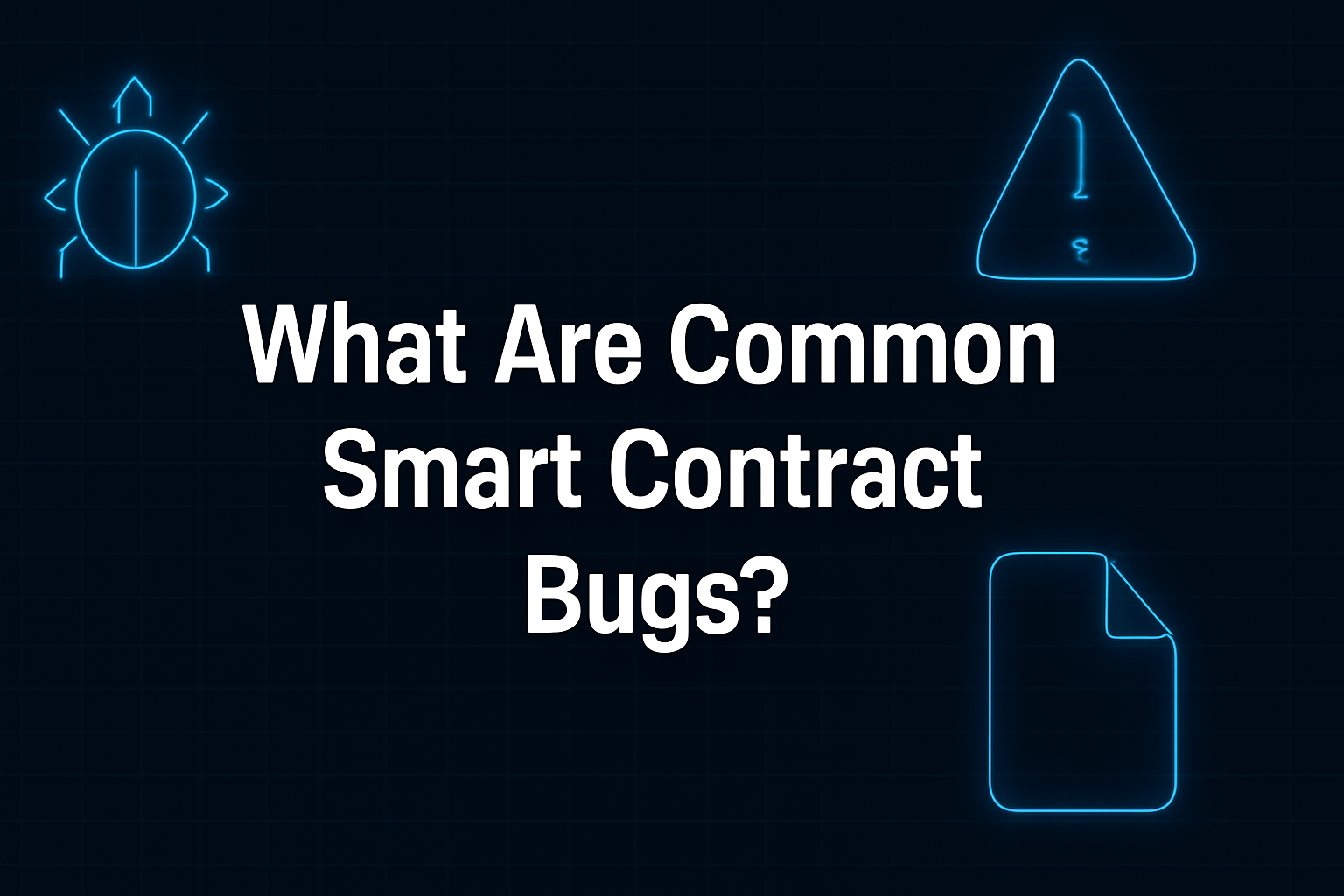
%201.svg)
%201.svg)
Smart contracts have revolutionized the blockchain ecosystem, enabling trustless execution of agreements and powering the decentralized finance revolution. However, these self-executing programs are not immune to vulnerabilities. In fact, smart contract bugs have resulted in billions of dollars in losses, making security one of the most critical concerns in the blockchain space.
According to recent data, a staggering $2.2 billion was stolen from crypto platforms in 2024, representing over 20 percent higher losses than 2023. Understanding common smart contract bugs is essential for developers, auditors, and investors alike. This comprehensive guide explores the most critical vulnerabilities affecting smart contracts in 2025, their real-world impacts, and how to protect against them.
Smart contracts control billions of dollars in crypto assets, making them prime targets for sophisticated attackers. Unlike traditional software, smart contracts deployed on blockchain networks are immutable—once deployed, they cannot be easily modified or patched. This permanence means that a single vulnerability can lead to devastating and irreversible financial losses.
The infamous DAO hack of 2016 exemplifies these risks. Attackers exploited a reentrancy vulnerability to drain over $60 million worth of Ether, an event so severe it led to an Ethereum hard fork and sparked ongoing debate about blockchain immutability versus security. More recently, the Cetus decentralized exchange hack in May 2025 resulted in an estimated $223 million in losses due to a missed code overflow check.
Smart contract security isn't just about protecting funds—it's about building trust, maintaining regulatory compliance, and ensuring the long-term viability of blockchain projects. As the industry matures, investors, institutions, and regulatory bodies increasingly require proof of security before engaging with blockchain platforms.
The Open Worldwide Application Security Project has developed the OWASP Smart Contract Top 10 for 2025, identifying today's leading vulnerabilities based on analysis of 149 security incidents documenting over $1.42 billion in financial losses across decentralized ecosystems. This comprehensive framework serves as the industry standard for understanding and mitigating smart contract risks.
The 2025 edition introduces updated rankings reflecting the evolving threat landscape, with notable additions including Price Oracle Manipulation and Flash Loan Attacks as distinct categories. These changes reflect the growing prevalence of DeFi exploits and demonstrate how attack vectors continue to evolve alongside blockchain technology.
Access control flaws remain the leading cause of financial losses in smart contracts, accounting for a staggering $953.2 million in damages in 2024 alone. These vulnerabilities occur when permission checks are improperly implemented, allowing unauthorized users to access or modify critical functions or data.
Access control vulnerabilities arise from poorly implemented permissions and role-based access controls that allow attackers to gain unauthorized control over smart contracts. Common issues include improperly configured onlyOwner modifiers, lack of proper role-based access control, and exposed admin functions.
The 88mph Function Initialization Bug provides a stark example, where attackers successfully reinitialized contracts to gain administrative privileges. This pattern of unauthorized admin actions has repeatedly proven to be the number one cause of smart contract hacks.
Developers should implement robust authorization mechanisms by verifying the sender of messages to restrict access to sensitive functions. Follow the principle of least privilege by using Solidity's state variable and function visibility specifiers to assign minimum necessary visibility levels. Regular security audits specifically focused on access control patterns are essential.
Never assume that functions will only be called by authorized parties—always implement explicit checks. Consider using established frameworks like OpenZeppelin's AccessControl for standardized, battle-tested permission management.
Logic errors represent the second most critical vulnerability category, causing $63.8 million in losses during 2024. These flaws in business logic or miscalculations in smart contracts can be exploited for financial gain or cause unexpected behavior that undermines contract functionality.
Logic errors, often called Business Logic Flaws, don't always present obvious security risks but can be exploited for economic gains through mechanisms like faulty reward distribution, incorrect fee calculations, and improper handling of edge cases. The vulnerability has climbed from position seven to position three in the 2025 rankings, reflecting an increase in sophisticated attacks targeting contract logic rather than code-level bugs.
Security isn't just about preventing obvious bugs—it's about ensuring contracts behave exactly as expected under all circumstances, including rare edge cases. A notable example is the SIR.trading DeFi protocol attack in March 2025, where logic flaws resulted in the theft of approximately $355,000.
Developers should thoroughly test all contract code, including every combination of business logic, verifying that observed behavior exactly matches intended behavior in each scenario. Consider using both manual code reviews and automated analysis tools to examine contract code for possible business logic errors.
Implement comprehensive unit tests covering normal operations, edge cases, and potential attack vectors. Use formal verification techniques when dealing with critical financial logic. Document all assumptions and expected behaviors clearly to facilitate review and testing.
Reentrancy attacks exploit a contract's ability to call external functions before completing its own state updates, resulting in $35.7 million in losses during 2024. This classic vulnerability gained infamy through the DAO hack and continues to plague smart contracts today.
Reentrancy attacks exploit coding vulnerabilities that enable external contracts to reenter functions before updating contract states. When smart contracts make external calls to other contracts before updating their own states, they face exposure to this vulnerability.
External contracts can exploit this weakness to perform repeated actions such as withdrawals, draining accounts of funds. The name "reentrancy" describes how external malicious contracts call back functions on vulnerable contracts and "re-enter" code execution at arbitrary locations.
From a historical perspective, reentrancy remains one of the most destructive attack vectors in Solidity smart contracts. The vulnerability has led to hundreds of millions of dollars in losses over recent years. ERC-777 tokens, which allow transaction notifications sent to recipients as callbacks, have been particularly vulnerable to reentrancy exploits.
Complete all state changes before calling external contracts—this simple principle eliminates most reentrancy vulnerabilities. Use function modifiers to prevent reentry, such as OpenZeppelin's ReentrancyGuard, which provides a robust, tested solution.
Implement the checks-effects-interactions pattern: perform all checks first, update all state variables second, and only then interact with external contracts. Consider using mutex locks for functions that must not be called recursively.
Flash loans allow users to borrow funds without collateral within a single transaction but can be exploited to manipulate markets or drain liquidity pools, causing $33.8 million in losses during 2024. While flash loans aren't technically a bug but rather a feature, attackers have learned to abuse them effectively.
Flash loan attacks involve borrowers obtaining large amounts of assets without collateral and manipulating DeFi protocols within a single transaction before repaying the loan. Attackers use these borrowed funds to manipulate pricing mechanisms, drain liquidity pools, and exploit market imbalances.
This vulnerability has become increasingly trendy over the past two years, with countless exploits targeting protocols that rely heavily on external price feeds. The attacks typically combine flash loans with other vulnerabilities to amplify their impact.
DeFi protocols must implement robust price oracle mechanisms that cannot be easily manipulated within a single transaction. Use time-weighted average prices from multiple sources rather than spot prices. Implement transaction limits and anomaly detection systems.
Consider using decentralized oracle networks like Chainlink that aggregate data from multiple sources. Add circuit breakers that pause contracts when unusual trading patterns are detected. Design economic models that make flash loan attacks unprofitable even if technically possible.
Integer overflow and underflow vulnerabilities occur when smart contract hackers introduce values falling outside the integer range allowed by a contract's defined fixed-size data types. This vulnerability, characteristic of blockchain virtual machines like Ethereum Virtual Machine, has historically caused significant losses.
Overflows exceed maximum values while underflows fall below minimum values. If the integer is signed, overflow yields the maximum negative value, while for unsigned integers, underflow yields the maximum value. These conditions allow attackers to increase account and token amounts, make excessive withdrawals, or alter contract logic for purposes like multiplying tokens or stealing funds.
Use Solidity compiler version 0.8.0 or higher, which automatically checks for overflows and underflows, providing built-in protection. For contracts compiled with earlier versions, check functions involving arithmetic operations or use a library like SafeMath to validate operations.
The Cetus decentralized exchange hack in May 2025, which cost an estimated $223 million, resulted from a missed code overflow check, demonstrating that even with modern protections, careful attention to arithmetic operations remains essential.
Smart contracts often interact with untrusted contracts, and failing to check return values can lead to silent failures or unintended execution, resulting in $550,700 in losses during 2024. This vulnerability has climbed from position ten to position six in 2025 rankings.
When contracts fail to verify the success of external calls, they risk proceeding with incorrect assumptions about transaction outcomes, leading to inconsistencies or exploitation by malicious actors. If you don't validate external calls, attackers will exploit them.
Always check return values from external contract calls. Use require statements to verify that calls succeeded before proceeding with subsequent logic. Consider using try-catch blocks for more sophisticated error handling in Solidity 0.6.0 and later.
Ensure calls are only made to trusted contracts when possible. Implement circuit breakers that can pause contract functionality if external dependencies fail unexpectedly. Document all external dependencies and their expected behaviors.
Insufficient input validation resulted in $14.6 million in losses during 2024. This vulnerability allows attackers to provide unexpected or malicious inputs that cause contracts to behave incorrectly.
Contracts must validate all inputs including function parameters, external data, and user-provided addresses. Failure to do so can result in division by zero errors, unauthorized access, incorrect calculations, and manipulation of contract state.
Implement comprehensive input validation at the entry point of every function. Use require statements to verify that inputs fall within expected ranges, formats, and types. Validate addresses to ensure they are not zero addresses or blacklisted addresses.
Consider using modifiers for common validation patterns to ensure consistency across your codebase. Document all input requirements and expected ranges clearly. Test extensively with edge cases and unexpected inputs.
DeFi protocols heavily rely on oracles, and manipulating price feeds can cause massive financial losses through flash loan exploits, price distortions, and market manipulation, causing $8.8 million in documented losses in 2024.
Price oracle manipulation has been added to the OWASP Top 10 for 2025 due to increasing exploit frequency. Attackers manipulate Uniswap TWAPs, Chainlink Oracles, and custom price feeds to drain liquidity pools and execute profitable arbitrage at the expense of protocols and users.
Use multiple independent price sources and implement sanity checks on price data. Avoid relying solely on on-chain DEX prices that can be manipulated within single transactions. Implement price deviation thresholds that trigger alerts or pause trading.
Consider using Chainlink Price Feeds or other decentralized oracle networks that aggregate data from multiple sources. Add time delays between price updates and critical operations. Monitor for unusual price movements and implement automatic circuit breakers.
Smart contracts, like any online service, are vulnerable to DoS attacks. By overloading services such as authentication mechanisms, attackers can block other contracts from executing or generate unexpected contract reverts.
DoS attacks can result in auction results or values used in financial transactions being manipulated to the attacker's advantage. Attackers may force contracts into states where they cannot process transactions or deliberately cause transactions to fail repeatedly.
Make DoS attacks costly for attackers through gas fees, time-lock puzzles, and rate limiting mechanisms. Ensure calls are only made to trusted contracts to reduce the likelihood of DoS attacks causing serious problems. Implement pull payment patterns rather than push payments to prevent malicious recipients from blocking distributions.
The Ethereum Improvement Proposal 7907 upgrade approved in April 2025 helps prevent contracts from falling victim to DoS attacks through improved gas metering, demonstrating ongoing ecosystem-level improvements in this area.
Blockchain's deterministic nature makes generating secure randomness challenging. Predictable randomness can compromise lotteries, token distributions, NFT reveals, and other functionalities relying on random outcomes.
On-chain randomness sources like block hashes, timestamps, and transaction data can be predicted or manipulated by miners and sophisticated actors. Relying on these sources for critical randomness needs creates exploitable vulnerabilities.
Use Chainlink VRF (Verifiable Random Function) or similar oracle-based randomness solutions that provide cryptographically secure and verifiable random numbers. Never rely solely on block hashes or timestamps for important random number generation.
For lower-stakes applications, consider commit-reveal schemes where users submit hashed values before revealing them. Implement proper waiting periods between commitment and revelation to prevent manipulation.
As blockchain security becomes increasingly complex, investors and developers need sophisticated tools to evaluate smart contract risks. Token Metrics, a leading AI-powered crypto analytics platform, provides crucial insights for assessing project security and making informed investment decisions.
Token Metrics helps users spot winning tokens early with powerful AI analytics, but beyond identifying opportunities, the platform evaluates fundamental security indicators that distinguish robust projects from vulnerable ones. The platform's Investor Grade scoring system incorporates code quality assessments, helping users identify projects with superior technical foundations.
Token Metrics assigns each token both a Trader Grade for short-term potential and an Investor Grade for long-term viability. The Investor Grade specifically considers technical factors including code quality, development activity, and security audit status—critical indicators of smart contract robustness.
Token Metrics leverages machine learning and data-driven models to deliver powerful, actionable insights across the digital asset ecosystem. The platform monitors thousands of projects continuously, tracking code updates, audit reports, and security incidents that might indicate smart contract vulnerabilities.
By analyzing development patterns, commit frequency, and team responsiveness to identified issues, Token Metrics helps investors avoid projects with poor security practices. The platform's real-time alerts notify users about significant code changes, audit failures, or security incidents that could affect their holdings.
Token Metrics provides personalized crypto research and predictions powered by AI, including detailed project analysis that often highlights security considerations. The platform's research team publishes regular updates on emerging threats, best practices, and security trends in the smart contract space.
Through Token Metrics' comprehensive dashboard, users can access information about project audits, known vulnerabilities, and historical security incidents. This transparency helps investors make risk-aware decisions rather than relying solely on marketing promises.
Token Metrics evaluates projects against industry security standards, considering whether teams have conducted professional audits, implemented bug bounty programs, and followed best practices in smart contract development. Projects demonstrating strong security commitments receive recognition in Token Metrics' rating system.
The platform's trading feature launched in 2025 ensures users can not only identify secure projects but also execute trades seamlessly, creating an end-to-end solution for security-conscious crypto investors.
Professional security audits have become essential for any serious blockchain project. Multiple specialized tools and services help developers identify vulnerabilities before deployment.
Slither stands out as one of the most comprehensive static analysis tools, offering robust API for scripting custom analyzers with low false-positive rates. The tool can analyze contracts created with Solidity compiler version 0.4 or higher, covering a broad collection of existing contracts. Slither discovers vulnerabilities including reentrancy issues, state variables without initialization, and code optimizations leading to higher gas fees.
Mythril employs symbolic execution and dynamic analysis to detect security vulnerabilities, providing detailed reports about potential issues. The tool performs thorough analysis combining static analysis, dynamic analysis, and symbolic execution techniques.
Echidna provides property-based fuzzing, challenging smart contracts with unexpected inputs to ensure they behave as intended under various conditions. This fuzzing approach discovers edge cases that manual testing might miss.
According to industry data, over $1.8 billion was lost to DeFi hacks in 2023 alone, mostly due to smart contract vulnerabilities. This has driven demand for professional auditing firms that provide human expertise alongside automated tools.
Top auditing companies in 2025 blend automated analysis with manual code review, penetration testing, attack simulations, fuzz testing, and governance risk assessments. This multi-layered approach uncovers deeper vulnerabilities that automated tools alone might miss.
Developers should document smart contract vulnerabilities and mistakes that others have made to avoid repeating them. Maintain a list of effective security practices followed by leading organizations, including keeping as much code off-chain as possible, writing small functions, splitting logic through multiple contracts, and creating thorough documentation.
Set up internal security teams that frequently audit source code for bugs, ensuring no exploitable issues exist. After performing audits, implement bug bounty programs where ethical hackers receive compensation for reporting vulnerabilities, providing an additional security layer.
As blockchain technology matures, so do the methods employed by attackers seeking to exploit vulnerabilities. The smart contract security landscape continues evolving rapidly, with new attack vectors emerging as quickly as defenses improve.
Looking ahead, advancements in artificial intelligence and machine learning promise even more sophisticated auditing tools offering deeper insights and more accurate assessments. AI-powered tools for predictive analysis and anomaly detection are gaining prominence, helping developers preemptively address potential security threats.
Token Metrics exemplifies this trend, using AI to analyze vast datasets of blockchain transactions, code repositories, and security incidents to identify patterns that might indicate vulnerabilities. This proactive approach helps investors and developers stay ahead of emerging threats.
Smart contract security increasingly intersects with regulatory compliance. As governments worldwide develop frameworks for digital assets, security standards are becoming more formalized. Projects must not only build secure contracts but also demonstrate compliance with evolving regulations.
The open-source nature of blockchain enables collective security improvements. Communities increasingly share vulnerability discoveries, audit reports, and security best practices. This collaborative approach accelerates identification and remediation of common vulnerabilities across the ecosystem.
Smart contract security is not a one-time checkbox but an ongoing commitment requiring vigilance, expertise, and the right tools. The vulnerabilities discussed in this guide—from access control failures to oracle manipulation—represent critical risks that have caused billions in losses.
Understanding these common bugs is the first step toward building more secure blockchain applications. Developers must implement defensive programming practices, utilize comprehensive auditing tools, and engage professional security firms before deploying contracts controlling significant value.
For investors, platforms like Token Metrics provide essential tools for evaluating project security and making informed decisions in an increasingly complex landscape. By combining AI-driven analytics with comprehensive project assessment, Token Metrics helps users identify projects with robust security foundations while avoiding those with critical vulnerabilities.
The future of blockchain depends on security. As the industry continues to mature, projects that prioritize security from the start—through proper development practices, comprehensive auditing, and continuous monitoring—will build the trust necessary for mainstream adoption. Whether you're developing smart contracts or investing in blockchain projects, understanding and addressing these common vulnerabilities is essential for success in the evolving world of decentralized finance.
Stay informed, stay secure, and leverage the best tools available to navigate the exciting but challenging landscape of smart contract development and blockchain investment in 2025 and beyond.
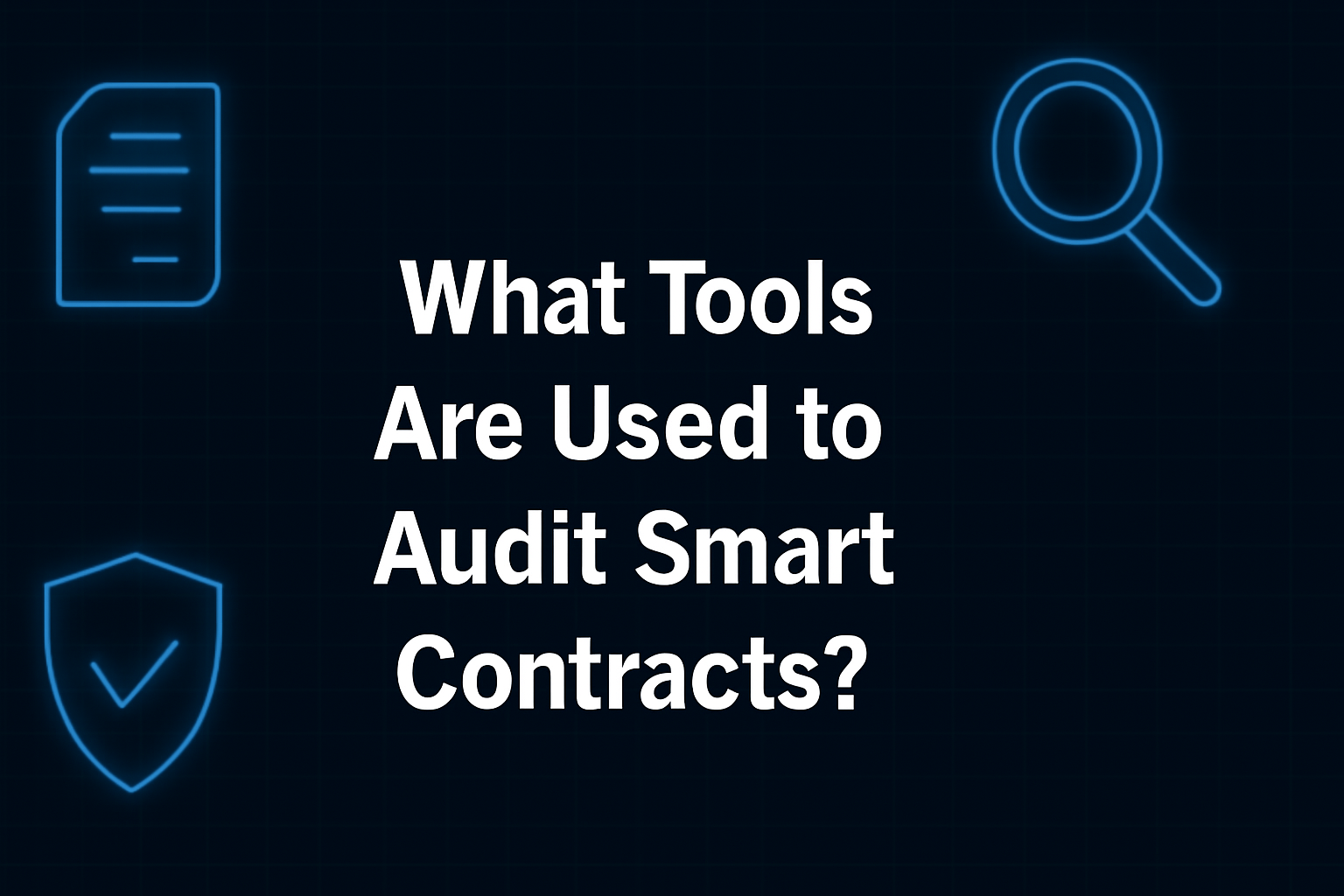
%201.svg)
%201.svg)
Smart contract security remains one of the most critical priorities in blockchain development. With over $2.2 billion stolen from crypto platforms in 2024—a 20% increase from the previous year—the importance of thorough smart contract auditing cannot be overstated. As decentralized applications control billions of dollars in assets, a single vulnerability can lead to devastating financial losses and irreparable damage to project credibility. This comprehensive guide explores the essential tools used to audit smart contracts in 2025, the methodologies behind effective security reviews, and why platforms like Token Metrics incorporate smart contract analysis into their comprehensive crypto analytics to protect investors from risky projects.
A smart contract audit involves detailed analysis of a protocol's code to identify security vulnerabilities, poor coding practices, and inefficient implementations before providing solutions to resolve these issues. During an audit, security experts review the code, logic, architecture, and security measures using both automated tools and manual processes to ensure the safety, reliability, and performance of decentralized applications.
The audit process typically begins with a code freeze, where the project stops making changes and provides auditors with comprehensive technical documentation including the codebase, whitepaper, architecture diagrams, and implementation details. This documentation gives auditors a high-level understanding of what the code aims to achieve, its scope, and exact implementation strategies.
Smart contract audits typically cost between $5,000 and $15,000 for smaller projects, though complex protocols with extensive codebases can require significantly higher investments. The time to complete an audit depends on code complexity, but thorough reviews generally take several weeks to ensure all potential vulnerabilities are identified and addressed.
Static analysis tools examine smart contract code without executing it, identifying vulnerabilities through pattern matching, data flow analysis, and abstract interpretation. These tools form the foundation of any comprehensive audit strategy.
Slither stands as one of the most powerful open-source static analysis tools for Solidity and Vyper smart contracts. Developed by Trail of Bits, Slither scrutinizes code to detect known vulnerabilities including reentrancy attacks, boolean equality issues, unused return values, and dangerous delegatecall operations.
The tool comes equipped with 92 built-in detectors and allows users to create custom detectors tailored to specific vulnerabilities of interest. This flexibility makes Slither particularly valuable for auditors who need to focus on project-specific security concerns. Additionally, Slither generates inheritance graphs and call graphs that map interactions between different functions within contracts, providing deeper insight into operational flow and system architecture.
Slither's fast execution speed enables rapid initial scans of codebases, making it ideal for continuous integration workflows where developers want immediate feedback on security issues. However, Slither is limited to Solidity and Vyper contracts, meaning projects using other smart contract languages need alternative tools.
Mythril is a security analysis tool for EVM bytecode that employs symbolic execution, SMT solving, and taint analysis to detect various security vulnerabilities. The tool can analyze deployed contracts by examining their bytecode directly, making it valuable for assessing contracts where source code may not be available.
MythX represents the commercial, enhanced version of Mythril, offering a more user-friendly interface and comprehensive analysis combining static analysis, dynamic analysis, and symbolic execution. The platform generates detailed reports accessible through its website, providing clear actionable insights for developers and auditors. However, MythX is a paid service with limited customization compared to open-source alternatives, and users cannot write their own detectors.
Aderyn represents the newer generation of static analysis tools, built with Rust for superior performance and accuracy. This AST (Abstract Syntax Tree) analyzer automatically examines Solidity codebases and identifies vulnerabilities in an easy-to-digest markdown format, making results accessible even for developers without deep security expertise.
Aderyn offers fast detection with low false-positive rates and integrates seamlessly into CI/CD pipelines, enabling automated security checks with every code commit. The tool allows for custom analyzer development, making it particularly useful for projects with unique security requirements or domain-specific vulnerabilities.
While static analysis examines code structure, dynamic analysis and fuzzing test smart contracts under actual execution conditions, discovering vulnerabilities that only appear during runtime.
Echidna, developed by Trail of Bits, uses property-based fuzzing to discover vulnerabilities by testing contracts against user-defined predicates. Rather than testing specific scenarios, Echidna generates random inputs to challenge smart contracts with unexpected data, ensuring they behave as intended under various conditions.
Developers define specific properties or assertions the smart contract should uphold, enabling Echidna to target testing efforts precisely and uncover vulnerabilities related to these properties. This approach is particularly effective for discovering edge cases that manual testing might miss, such as integer overflows, unexpected state transitions, or authorization bypasses under specific conditions.
Echidna's flexibility and comprehensive toolset make it ideal for developers seeking to break even the most difficult assertions before deployment. The tool has identified critical vulnerabilities in major protocols that passed initial audits, demonstrating the value of thorough fuzzing in the security toolkit.
Medusa represents an experimental evolution of Echidna, offering parallelized fuzz testing across multiple threads for dramatically improved performance. This cross-platform, go-ethereum-based smart contract fuzzer enables developers to implement custom, user-defined testing methods through both CLI and Go API interfaces.
Medusa supports assertion and property testing with built-in capabilities for writing Solidity test cases. The tool's parallel execution across multiple workers significantly reduces testing time while increasing coverage, making it suitable for large, complex protocols where comprehensive fuzzing might otherwise be impractical. Coverage-guided fuzzing helps Medusa achieve deeper analysis by focusing on code paths that haven't been adequately tested.
Foundry has emerged as a complete smart contract development and auditing framework that combines multiple testing approaches into a unified toolkit. The framework includes Forge for testing and fuzzing, Cast for contract interactions, Anvil as a local Ethereum node, and Chisel for Solidity REPL testing.
Foundry's integrated approach enables developers to write tests in Solidity itself rather than JavaScript or other languages, reducing context switching and making tests more natural for smart contract developers. The framework supports multi-blockchain projects and enables fast integration with different networks, providing flexibility for cross-chain applications.
Formal verification tools use mathematical techniques to prove that smart contracts behave correctly under all possible conditions, providing the highest assurance level available.
Halmos, developed by a16z, represents an open-source formal verification tool employing bounded symbolic execution to analyze contract logic. Unlike testing that checks specific scenarios, symbolic execution explores all possible execution paths within defined bounds, mathematically proving correctness or identifying counterexamples where the contract fails.
The tool avoids the halting problem through bounded execution, making verification computationally tractable while still providing strong security guarantees. Halmos is designed specifically for formal verification workflows, making it valuable for high-stakes protocols where mathematical certainty is required.
Scribble translates high-level specifications into Solidity code, enabling runtime verification of smart contracts. Developers write specifications describing how contracts should behave, and Scribble generates assertion code that verifies these properties during execution.
This approach bridges formal verification and practical testing, allowing developers to express security properties in natural language-like syntax that Scribble converts to executable checks. Integration with other tools like Diligence Fuzzing creates powerful workflows where specifications guide automated security testing.
Professional audit firms offer comprehensive cloud-based platforms that combine multiple analysis techniques with expert manual review.
ConsenSys Diligence provides industry-leading smart contract auditing services combining automated analysis tools with hands-on review from veteran auditors. Their platform offers APIs for affordable smart contract security options integrated directly into development environments, enabling continuous security analysis throughout the development lifecycle.
Diligence Fuzzing, powered by Harvey (a bytecode-level fuzzer), provides cloud-based automated testing with integration to Foundry and Scribble. The service identifies vulnerabilities through comprehensive fuzzing campaigns that would be impractical to run locally, providing detailed reports on potential issues.
ConsenSys Diligence has completed audits for major protocols including 0x, Keep Network, and Horizon Games, establishing themselves as trusted partners for enterprise blockchain projects requiring the highest security standards.
Cyfrin and QuillAudits represent next-generation audit firms leveraging cutting-edge tools and methodologies. QuillAudits has completed over 1,400 audits across Ethereum, Polygon, Solana, Arbitrum, BSC, and other chains, securing over $3 billion in assets.
These firms combine automated tool suites with expert manual review, providing comprehensive security assessments that cover not just code vulnerabilities but also economic attack vectors, governance risks, and architectural weaknesses that purely automated tools might miss.
Tenderly enables realistic transaction simulation and debugging in real-time, making it ideal for DeFi projects where understanding complex transaction flows is critical. The platform allows developers to simulate transactions before execution, identifying potential failures, unexpected behavior, or security issues in a safe environment.
Ganache creates private blockchain networks for testing smart contracts, enabling developers to simulate transactions without gas costs. This local testing environment allows rapid iteration and comprehensive testing scenarios before mainnet deployment, significantly reducing development costs while improving security.
Solodit aggregates smart contract vulnerabilities and bug bounties from multiple sources, serving as a research hub for auditors and security researchers. With a database of over 8,000 vulnerabilities, bug bounty tracking, and auditing checklists, Solodit helps security professionals stay informed about emerging threats and learn from past exploits.
While the tools discussed above focus on code-level security, investors need accessible ways to assess smart contract risks before committing capital. This is where Token Metrics distinguishes itself as the premier AI-powered crypto trading and analytics platform, incorporating smart contract security analysis into its comprehensive token evaluation framework.
Token Metrics leverages advanced AI to analyze thousands of cryptocurrency projects, including comprehensive smart contract security assessments. The platform's risk analysis framework evaluates whether projects have undergone professional audits, identifies red flags in contract code such as ownership centralization or hidden mint functions, assesses the reputation and track record of audit firms employed, and tracks historical security incidents and how projects responded.
This analysis is distilled into clear Trader Grades (0-100) and Investor Grades that incorporate security considerations alongside market metrics, technical indicators, and fundamental analysis. Investors receive actionable intelligence about project safety without needing to understand complex audit reports or review smart contract code themselves.
Token Metrics provides real-time alerts about security-related developments affecting tokens in users' portfolios or watchlists. This includes notifications when new audit reports are published, smart contract vulnerabilities are disclosed, suspicious on-chain activity is detected, or governance proposals could affect protocol security. This proactive monitoring helps investors avoid or exit positions in projects with emerging security concerns before exploits occur.
Token Metrics' integrated trading platform (launched March 2025) incorporates security scores directly into the trading interface. Users can see at a glance whether tokens they're considering have passed reputable audits, enabling informed decisions that balance opportunity against risk. This integration ensures security considerations remain front-of-mind during trade execution rather than being afterthoughts.
Effective smart contract security in 2025 requires multi-layered approaches combining multiple tools and methodologies. Start security testing early in development rather than treating audits as a pre-launch formality. Integrate automated tools into CI/CD pipelines for continuous security monitoring throughout the development process.
Use complementary tools rather than relying on single solutions. Combine static analysis (Slither), dynamic testing (Echidna/Medusa), formal verification (Halmos), and manual review for comprehensive coverage. No single tool catches all vulnerability types, so layered approaches significantly improve security.
Engage professional audit firms for final reviews before mainnet deployment. While automated tools catch many issues, experienced auditors identify complex vulnerabilities, economic attack vectors, and architectural weaknesses that require human expertise and creativity to discover.
Smart contract security tools have evolved dramatically, offering developers and auditors powerful capabilities for identifying vulnerabilities before deployment. From static analysis tools like Slither and Aderyn to dynamic fuzzing with Echidna and Medusa, formal verification with Halmos, and enterprise platforms from ConsenSys Diligence and Cyfrin, the security toolkit available in 2025 provides comprehensive coverage for protecting decentralized applications.
For investors and traders, platforms like Token Metrics make smart contract security accessible by incorporating audit analysis and risk assessment into comprehensive token evaluations. By combining automated analysis with expert insights and real-time monitoring, Token Metrics helps users identify secure projects while avoiding those with unaudited or vulnerable smart contracts—protecting capital while enabling profitable participation in the DeFi ecosystem. Whether you're a developer building smart contracts or an investor evaluating projects, prioritizing security through the right tools and platforms is essential for long-term success in blockchain technology.

%201.svg)
%201.svg)
The cryptocurrency landscape has evolved dramatically, offering investors multiple avenues to generate passive income from their digital assets. Three primary strategies have emerged as the most popular ways to earn returns: staking, yield farming, and lending. While these methods share the common goal of generating yield, they operate through fundamentally different mechanisms, each with unique risk profiles and potential rewards.
Understanding these distinctions is crucial for making informed investment decisions in 2025's rapidly evolving crypto ecosystem. Whether you're a conservative investor seeking stable returns or an aggressive trader chasing higher yields, knowing which strategy aligns with your goals can significantly impact your portfolio performance.
Staking represents one of the most straightforward methods for earning passive income in cryptocurrency. The process involves locking up cryptocurrency to support blockchain network operations, earning rewards typically in the form of additional tokens. This mechanism is closely tied to Proof-of-Stake consensus protocols, which have largely replaced energy-intensive Proof-of-Work mining.
Staking requires users to lock their crypto assets to act as validators and verify blocks on blockchain networks. When you stake your tokens, you're essentially helping to secure the network and validate transactions. In return for this service, you receive a portion of transaction fees and newly minted tokens as rewards.
The staking process can be compared to a government bond in traditional finance. When you purchase a bond, you're lending the government money, which they pay back through taxation or printing currency, and similarly, when you stake, you're putting crypto into a smart contract and earning newly minted cryptocurrency along with a portion of transaction fees.
The staking market shows significant variation across different assets and platforms, with Ethereum staking offering returns ranging from 2.02% to 3.5%, while Solana provides more attractive yields between 5.1% and 9.39% across various platforms. However, investors must account for network inflation when calculating real returns.
Major platforms supporting staking include both centralized exchanges like Coinbase and decentralized protocols like Rocketpool and Lido. Centralized platforms operate similarly to commercial banks, accepting deposits and lending them out while sharing interest with depositors.
Benefits:
Risks:
Yield farming emerged as one of the most innovative DeFi strategies, offering potentially higher returns than traditional staking. The strategy involves lending or providing liquidity to decentralized finance platforms, with earnings often higher but subject to market volatility and smart contract vulnerabilities.
Yield farming represents the DeFi version of rehypothecation, where assets are re-used multiple times to maximize returns. Users deposit cryptocurrency into liquidity pools on DeFi platforms like Uniswap, PancakeSwap, or Aave. These pools facilitate trading, lending, and borrowing activities within the ecosystem.
When you provide liquidity, you receive liquidity provider (LP) tokens representing your share of the pool. These LP tokens can be used to deposit or stake on another DeFi platform, allowing farmers to multiply their returns. This multi-layered approach to earning enables yield farmers to achieve returns that significantly exceed traditional staking.
Current yields vary by market conditions, but stablecoins like USDT or DAI often offer 10-20% APY on specific platforms, while riskier tokens or new liquidity pairs may offer higher APY with greater volatility and risk. The competition for liquidity means that pools often compete by offering increasingly attractive annual percentage yields.
Leading platforms include Aave with approximately $40.3 billion in total value locked, offering multi-chain support across Ethereum, Polygon, Avalanche, and Arbitrum networks. PancakeSwap dominates the Binance Smart Chain ecosystem with significantly lower transaction costs and gamified farming options.
Benefits:
Risks:
Crypto lending operates similarly to traditional banking but with cryptocurrency as the underlying asset. You deposit cryptocurrencies or stablecoins into an account, and the platform lends those assets to borrowers such as retail borrowers, institutional traders, or market makers at a higher rate, with you receiving a portion of the interest as yield.
To earn through lending, you provide a crypto asset that other users want to borrow by depositing it into a lending pool, receiving interest according to the annual percentage yield shown, which is subject to change as market conditions shift.
On the borrowing side, users must provide collateral to secure loans. On platforms like Sovryn, loans are overcollateralized, meaning borrowers need to provide more collateral than the value of what they're borrowing. This overcollateralization helps protect lenders from default risk.
Some platforms in 2025 offer around 5-15% APY on stablecoins with flexible access, while locking up funds for longer terms like 1-3 months might yield higher returns. The CeFi lending market has grown substantially, with active loan volumes exceeding $22 billion by Q1 2025.
Lending carries significantly higher risks in 2025, with counterparty risk being the primary concern as borrowers may default on loans, and platform insolvency represents the defining risk as demonstrated by catastrophic failures of major platforms in 2022-2023.
The collapse of several major lending platforms fundamentally altered the risk-reward calculation for crypto lending. Unlike traditional banking, cryptocurrency deposits lack FDIC insurance protection, leaving investors vulnerable to platform failures.
Benefits:
Risks:
Understanding how these three strategies differ is essential for choosing the right approach for your investment goals.
Staking is often considered the lowest-risk option involving locking assets in a blockchain network with risk primarily from cryptocurrency value fluctuations, while yield farming carries higher risk with potential for impermanent loss and smart contract vulnerabilities, and liquidity mining faces similar risks including price fluctuations and protocol vulnerabilities.
For most investors in 2025, staking provides superior risk-adjusted returns compared to lending, as devastating platform failures of 2022-2023 fundamentally shifted the risk-reward calculation, with staking protocols continuing to operate through market turmoil while lending platforms collapsed with billions in customer funds.
Staking is a long-term investment requiring users to lock cryptocurrency for a specific period, while yield farming and liquidity mining can be short-term investments since users can provide liquidity or lend for shorter durations.
Staking usually offers more predictable and stable returns and often requires less frequent management compared to yield farming. Yield farming demands active monitoring of multiple pools, gas fees, and market conditions to maximize returns.
Staking offers lower returns as it primarily involves securing the network, yield farming offers higher returns by moving cryptocurrencies between liquidity pools for the best ROI, and liquidity mining offers the highest returns by providing liquidity to specific cryptocurrencies to boost their liquidity.
However, higher potential returns come with proportionally higher risks. The most profitable strategies often involve the newest and most volatile tokens, which carry substantial downside risk.
In staking, user tokens are not being used for liquidity provision with no impact on market liquidity, while in yield farming and liquidity mining, user tokens provide liquidity to decentralized exchanges which can impact market liquidity.
Staking typically involves lock-up periods ranging from days to months, during which assets cannot be withdrawn without penalties. Yield farming offers more flexibility, allowing users to remove liquidity at any time, though this may result in impermanent loss.
Navigating the complex landscape of staking, farming, and lending requires sophisticated tools and data-driven insights. This is where Token Metrics, a leading AI-powered crypto analytics platform, becomes invaluable for both novice and experienced investors.
Token Metrics provides personalized crypto research and predictions powered by AI, helping users spot winning tokens early with powerful AI analytics and offering real-time AI buy and sell signals. The platform has evolved from a pure analytics solution into a comprehensive end-to-end crypto investment ecosystem.
Token Metrics assigns each token a Trader Grade for short-term potential and an Investor Grade for long-term viability, allowing users to prioritize opportunities efficiently. This dual-rating system helps investors distinguish between assets suitable for quick trading gains versus those appropriate for long-term staking strategies.
Token Metrics stands out with its proven AI-driven analytics, moonshot altcoin discovery, real-time signals and alerts, tools for long-term investing and short-term trading, and the infrastructure to build custom AI crypto bots and agents.
The platform's Moonshots feature uses artificial intelligence to highlight tokens with 10x to 100x potential before they reach major exchanges, giving users an early-mover advantage in identifying promising farming opportunities.
For passive investors, AI-managed indices dynamically rebalance portfolios based on market conditions, offering diversified exposure to both established assets and emerging "moonshot" tokens identified through predictive analytics.
Token Metrics has historically focused on providing AI-driven analytics and proprietary ratings, but the launch of Trading on Token Metrics transforms the platform into an end-to-end solution, enabling traders to review ratings and token details pages and swiftly act on market signals without leaving the ecosystem.
This seamless integration between research and execution allows users to analyze staking yields, compare farming opportunities, and evaluate lending platforms all within a single interface. The platform's multi-chain support ensures you can access opportunities across various blockchain networks efficiently.
Token Metrics incorporates risk management tools like stop-loss orders, position sizing, and continuous performance monitoring to mitigate volatility risks, while using natural language processing to interpret social media trends and sentiment to help traders anticipate market movements.
By monitoring hundreds of tokens across exchanges, Token Metrics enables users to respond to market shifts in seconds—critical in a space where timing determines profitability. Customizable alerts via email, SMS, or messaging apps ensure you never miss important opportunities or risk signals.
Selecting between staking, farming, and lending depends on several personal factors:
Choose Staking If:
Choose Yield Farming If:
Choose Lending If:
Choosing between these strategies ultimately depends on individual preferences and circumstances, with factors such as available capital, investment horizon, and familiarity with the crypto market influencing the decision.
Regardless of which strategy you choose, following these best practices will help optimize returns while managing risk:
The cryptocurrency ecosystem continues to mature, with institutional adoption increasing and regulatory frameworks developing. Token Metrics leverages machine learning and data-driven models to deliver powerful, actionable insights across the digital asset ecosystem, positioning investors to capitalize on emerging opportunities.
As blockchain technology advances, we can expect more sophisticated yield optimization strategies, improved security measures, and greater integration between different earning mechanisms. Platforms that combine robust analytics with user-friendly interfaces will be essential for navigating this evolving landscape.
The distinction between staking, farming, and lending will likely blur as protocols develop hybrid models offering the benefits of multiple approaches. Cross-chain compatibility will expand, allowing seamless movement of assets between different blockchain networks to capture the best yields.
Staking, yield farming, and lending each offer unique pathways to generating passive income from cryptocurrency holdings. Staking provides the most conservative approach with predictable returns and lower risk. Yield farming offers higher potential rewards for those willing to actively manage positions and accept greater volatility. Lending sits in the middle, offering competitive returns with flexibility but carrying significant platform risk.
Success in crypto yield generation requires matching your strategy to your risk tolerance, time commitment, and investment goals. Whether you're a cautious long-term holder or an aggressive yield optimizer, understanding these fundamental differences empowers you to make informed decisions.
By leveraging sophisticated analytics platforms like Token Metrics, investors can navigate this complex landscape with confidence, identifying the best opportunities while managing risk effectively. The combination of AI-driven insights, real-time monitoring, and integrated trading tools provides a significant advantage in today's fast-moving crypto markets.
As you embark on your yield generation journey, remember that the crypto market rewards preparation, discipline, and continuous learning. Start with solid fundamentals, diversify your approach, and use the best tools available to maximize your returns while protecting your capital in 2025 and beyond.

%201.svg)
%201.svg)
The decentralized revolution has transformed how we think about digital projects, but it's also complicated how we evaluate their performance. Unlike traditional startups where metrics like revenue, user growth, and profit margins tell a clear story, Web3 projects operate in a multidimensional ecosystem where success can mean different things to different stakeholders. So how do you truly measure success in this brave new world?
When most people think about measuring Web3 project success, their minds immediately jump to token prices and market capitalization. While these financial metrics matter, they're just the tip of the iceberg. A comprehensive evaluation requires looking at technical innovation, community engagement, protocol adoption, and long-term sustainability.
Token performance remains a critical indicator, but it needs context. A project might have a modest market cap while solving genuine problems and building sustainable infrastructure. Conversely, projects with massive valuations sometimes lack fundamental utility. This is where sophisticated analytics platforms become invaluable for separating signal from noise.
Real usage tells the truth. Daily active addresses, transaction volume, total value locked (TVL), and smart contract interactions provide objective data about whether people actually use a protocol. A project might generate massive hype on social media, but if on-chain activity remains stagnant, that's a red flag.
Transaction velocity shows how frequently tokens move between addresses, indicating genuine economic activity rather than passive holding. Gas fees consumed by a protocol on Ethereum or other networks demonstrates demand for its services. These metrics can't be easily manipulated and provide authentic insight into project health.
The power of Web3 lies in its communities. Measuring community engagement goes beyond counting Twitter followers or Discord members. True community strength reveals itself through developer contributions on GitHub, governance participation rates, and the diversity of token holders.
Decentralization metrics are particularly important. How distributed is token ownership? Are decision-making powers concentrated among a few whales, or broadly distributed? The Nakamoto coefficient—measuring how many entities would need to collude to attack a network—provides valuable insight into a project's resilience.
Active development indicates long-term viability. The number of commits, contributors, and repositories in a project's GitHub shows whether talented developers believe in the vision enough to dedicate their time. Development velocity matters more than short-term price action.
Technical milestones achieved versus roadmap promises offer another reality check. Does the team deliver on commitments, or do deadlines constantly slip? Regular audits, bug bounties, and security practices demonstrate professionalism and reduce risk for users and investors.
Traditional financial analysis still applies, but with Web3 twists. Revenue generation for protocols can come from transaction fees, staking rewards, or other mechanisms. Understanding a project's actual cash flows versus speculative value is crucial.
Tokenomics sustainability requires scrutiny. High inflation rates might artificially boost staking yields while diluting existing holders. Vesting schedules for team tokens, treasury management strategies, and emission rates all impact long-term token value and project sustainability.
The market cap to TVL ratio helps evaluate whether a DeFi protocol is over or undervalued relative to the capital it secures. Meanwhile, price-to-sales ratios adapted for crypto can compare protocol revenue against token valuation, similar to traditional stocks but accounting for token utility.
Navigating this complexity requires sophisticated tools. Token Metrics stands out as a top crypto trading and analytics platform that helps investors and researchers cut through the noise. By aggregating on-chain data, social sentiment, technical analysis, and fundamental metrics into comprehensive scoring systems, platforms like Token Metrics enable more informed decision-making.
What sets advanced analytics platforms apart is their ability to provide AI-driven insights that would take individuals countless hours to compile manually. Token Metrics, for instance, offers trader-grade ratings, risk assessments, and portfolio management tools specifically designed for the unique challenges of crypto markets. Their quantitative approach combines traditional financial analysis with crypto-native metrics, giving users a holistic view of project viability.
For serious Web3 participants, leveraging such platforms isn't optional—it's essential. The market moves too fast and the data landscape is too complex for manual analysis alone.
Successful Web3 projects rarely exist in isolation. Strategic partnerships, integrations with other protocols, and cross-chain compatibility indicate ecosystem adoption. When major platforms choose to integrate a project's technology, it validates the technical approach and expands the potential user base.
Institutional adoption has become increasingly important. Are venture capital firms, family offices, or traditional institutions using or investing in the protocol? While Web3 champions decentralization, institutional validation often precedes mainstream adoption.
Short-term hype cycles are easy to spot in retrospect but difficult to resist in real-time. Sustainable projects demonstrate consistent value creation over multiple market cycles. They adapt to changing conditions, survive bear markets, and emerge stronger.
Treasury management reveals a lot about project maturity. Does the team responsibly manage funds, diversify beyond their own token, and plan for extended development timelines? Or do they burn through capital quickly and require constant fundraising?
Measuring success also means identifying failure patterns. Abandoned GitHub repositories, decreasing active addresses, team members departing, broken roadmap promises, and centralized control masquerading as decentralization all signal trouble ahead.
Excessive focus on token price rather than product development, unrealistic yield promises, and opacity around operations should trigger skepticism. The best projects obsess over building useful products, not just pumping token prices.
Measuring Web3 project success requires balancing multiple dimensions: technical achievement, community strength, financial sustainability, and real-world adoption. No single metric tells the complete story, which is why comprehensive analysis frameworks matter so much.
For investors, developers, and users, leveraging advanced analytics platforms like Token Metrics provides the data-driven foundation needed to separate legitimate innovation from vaporware. As the Web3 ecosystem matures, the projects that consistently deliver value across multiple success dimensions will likely emerge as the lasting winners in this transformative technological shift.
Success in Web3 isn't just about price—it's about building the decentralized infrastructure that will power the next generation of the internet.

%201.svg)
%201.svg)
The blockchain industry has evolved far beyond Bitcoin's isolated ledger. Today's crypto ecosystem demands something more sophisticated: the ability for different blockchains to talk to each other. This interoperability challenge has sparked innovative solutions that are reshaping how digital assets and information flow across decentralized networks.
Blockchains were originally designed as independent, self-contained networks. Bitcoin operates on its own blockchain, Ethereum on another, and thousands of other cryptocurrencies each maintain their own separate ledgers. This isolation creates a significant problem: blockchains cannot natively communicate with each other, making it difficult to transfer assets or share data between different networks.
Think of it like having different banking systems that can't process transfers between each other. You might have funds in one bank, but you can't easily move them to another without going through complex intermediaries. This fragmentation limits the potential of blockchain technology and creates friction for users who want to leverage multiple networks.
Bridge protocols have emerged as the most common solution for cross-chain communication, acting as intermediaries that facilitate asset transfers between different blockchains. These bridges work by locking assets on one chain and minting equivalent representations on another.
For example, if you want to move Ethereum tokens to the Binance Smart Chain, a bridge protocol would lock your ETH on Ethereum and issue wrapped tokens on BSC that represent the same value. When you want to move back, the process reverses: the wrapped tokens are burned, and your original ETH is unlocked.
However, bridges come with trade-offs. Security vulnerabilities in bridge protocols have led to some of the largest cryptocurrency heists in history, with billions of dollars stolen from compromised bridges. The centralization of some bridge solutions also contradicts blockchain's decentralized ethos.
Beyond simple asset transfers, advanced cross-chain messaging protocols enable more sophisticated interactions between blockchains. These protocols allow smart contracts on one blockchain to trigger actions on another, opening possibilities for complex decentralized applications that span multiple networks.
Protocols like Cosmos IBC (Inter-Blockchain Communication) and Polkadot's Cross-Consensus Message Format enable direct blockchain-to-blockchain communication without requiring centralized intermediaries. These systems use cryptographic proofs and validator networks to ensure messages are authentic and securely delivered.
The Cosmos ecosystem, for instance, creates an "internet of blockchains" where independent chains can communicate through a standardized protocol. Each blockchain maintains its sovereignty while gaining the ability to interact with other chains in the network.
Atomic swaps represent another approach to cross-chain interaction, enabling peer-to-peer cryptocurrency exchanges without intermediaries. These swaps use hash time-locked contracts that ensure either both parties receive their assets or the transaction fails completely, eliminating the risk of one party taking funds without fulfilling their end of the deal.
While atomic swaps offer strong security guarantees, they're limited in functionality compared to bridge protocols and work best for simple asset exchanges rather than complex cross-chain operations.
Blockchain oracles play a crucial supporting role in cross-chain communication by providing external data that smart contracts need to function. Oracle networks like Chainlink enable blockchains to access off-chain information and data from other blockchains, creating bridges between isolated networks and the broader world.
These decentralized oracle networks aggregate data from multiple sources, verify its accuracy, and deliver it to smart contracts in a trustworthy manner. This infrastructure is essential for many cross-chain applications that need reliable information from multiple blockchains.
Layer 2 scaling solutions, particularly rollups, are changing how we think about blockchain communication. Rather than connecting entirely separate blockchains, rollups process transactions off the main chain and periodically submit batches of data back to the base layer.
Optimistic rollups and zero-knowledge rollups inherit the security of their underlying blockchain while dramatically increasing transaction throughput, effectively creating interconnected layers that communicate through data compression and cryptographic proofs.
This approach maintains the security of the base layer while enabling faster, cheaper transactions that still benefit from the main blockchain's guarantees.
As blockchain interoperability evolves, traders and investors face increasingly complex decisions about which networks, bridges, and cross-chain protocols to use. This is where comprehensive analytics become invaluable.
Token Metrics stands out as a leading crypto trading and analytics platform that helps users navigate the multi-chain landscape with confidence. The platform provides advanced metrics, AI-powered analysis, and real-time data across multiple blockchains, enabling traders to identify opportunities and risks in cross-chain ecosystems.
With Token Metrics, users can analyze token performance across different networks, evaluate the security and efficiency of various bridge protocols, and make data-driven decisions about cross-chain investments. The platform's comprehensive dashboard aggregates information from numerous blockchains, providing the multi-chain visibility that modern crypto trading demands.
Whether you're evaluating which blockchain offers the best opportunities for specific tokens, comparing cross-chain protocols, or analyzing the risk profiles of different bridge solutions, Token Metrics delivers the analytical depth needed to succeed in today's interconnected crypto markets.
The future points toward increasingly seamless cross-chain communication. Emerging technologies like zero-knowledge proofs are enabling more secure and efficient verification of cross-chain transactions without revealing sensitive information.
We're moving toward a future where users won't need to think about which blockchain they're using. Cross-chain communication will happen automatically in the background, similar to how internet users don't worry about which servers their data passes through. The technology will simply work.
Standards are also emerging to create more unified approaches to interoperability. As the industry matures, we'll likely see consolidation around proven protocols that offer the best balance of security, speed, and decentralization.
Blockchain communication across networks represents one of the most critical developments in cryptocurrency's evolution. From bridge protocols and atomic swaps to sophisticated messaging systems and Layer 2 solutions, the industry has developed multiple approaches to solving the interoperability challenge.
As these technologies mature and become more secure, the vision of a truly interconnected blockchain ecosystem moves closer to reality. For traders and investors navigating this complex landscape, platforms like Token Metrics provide the analytical tools necessary to understand cross-chain dynamics and capitalize on emerging opportunities in the multi-chain future.


 Create Your Free Account
Create Your Free Account9450 SW Gemini Dr
PMB 59348
Beaverton, Oregon 97008-7105 US
.svg)




.png)
Token Metrics Media LLC is a regular publication of information, analysis, and commentary focused especially on blockchain technology and business, cryptocurrency, blockchain-based tokens, market trends, and trading strategies.
Token Metrics Media LLC does not provide individually tailored investment advice and does not take a subscriber’s or anyone’s personal circumstances into consideration when discussing investments; nor is Token Metrics Advisers LLC registered as an investment adviser or broker-dealer in any jurisdiction.
Information contained herein is not an offer or solicitation to buy, hold, or sell any security. The Token Metrics team has advised and invested in many blockchain companies. A complete list of their advisory roles and current holdings can be viewed here: https://tokenmetrics.com/disclosures.html/
Token Metrics Media LLC relies on information from various sources believed to be reliable, including clients and third parties, but cannot guarantee the accuracy and completeness of that information. Additionally, Token Metrics Media LLC does not provide tax advice, and investors are encouraged to consult with their personal tax advisors.
All investing involves risk, including the possible loss of money you invest, and past performance does not guarantee future performance. Ratings and price predictions are provided for informational and illustrative purposes, and may not reflect actual future performance.


